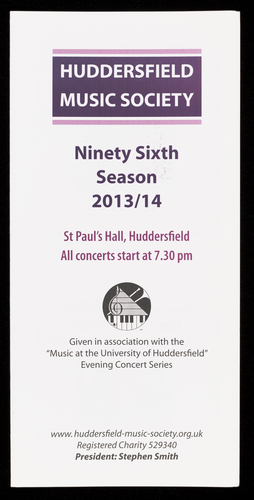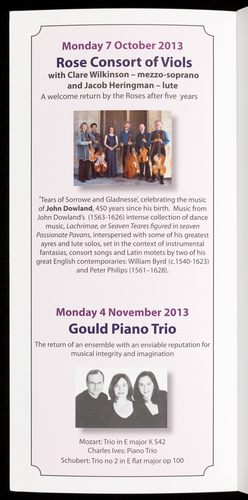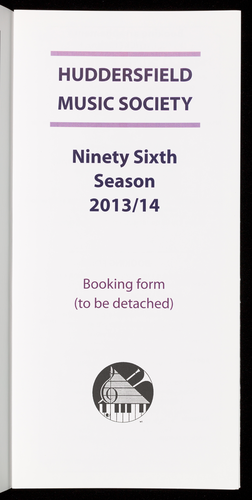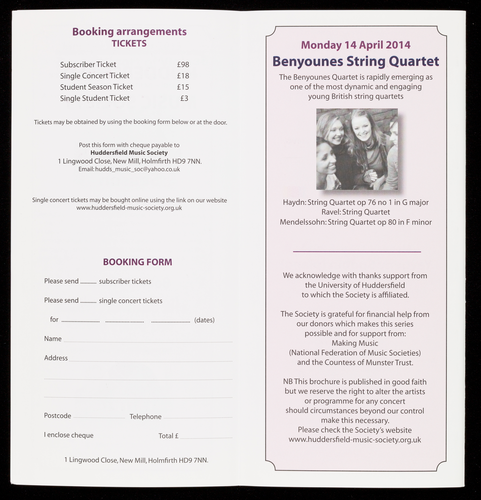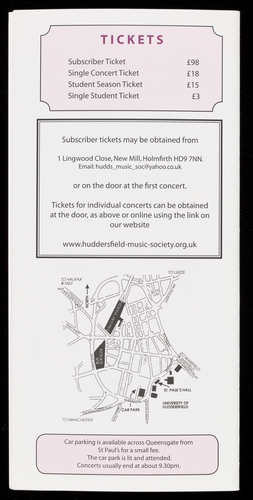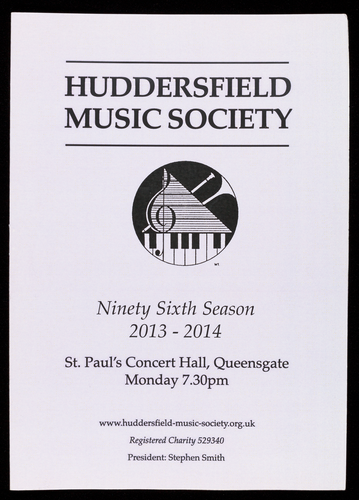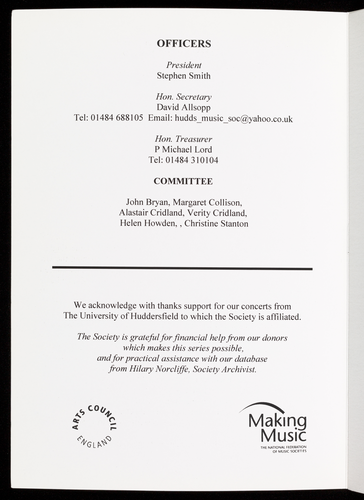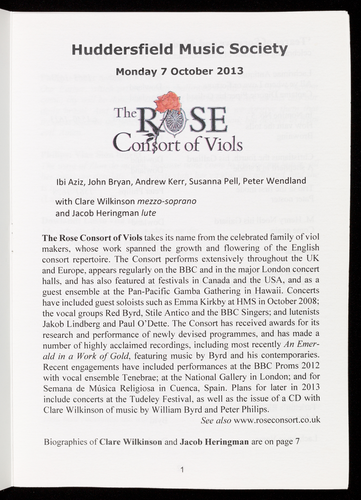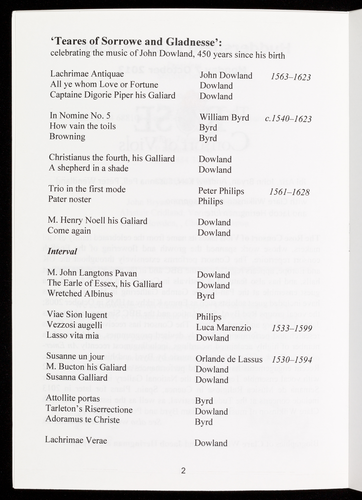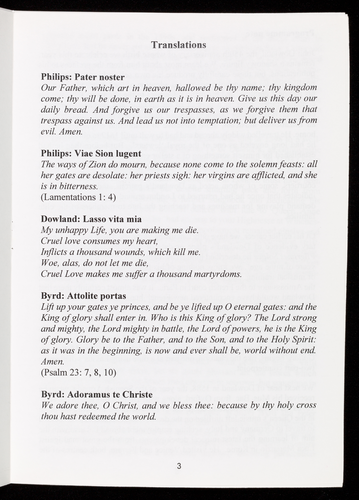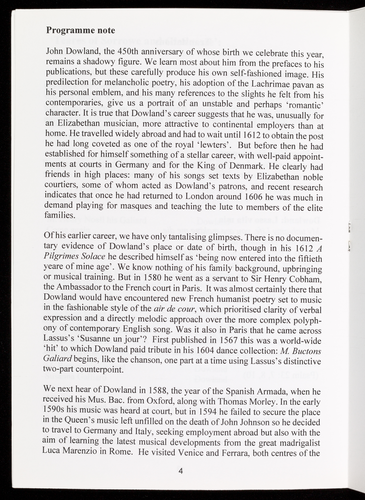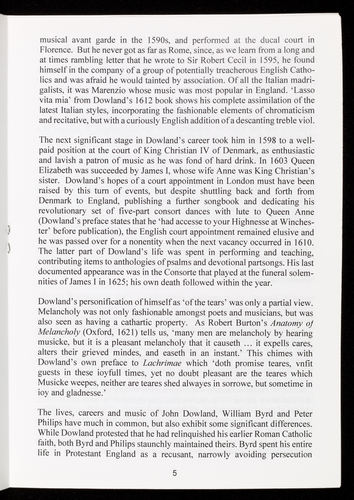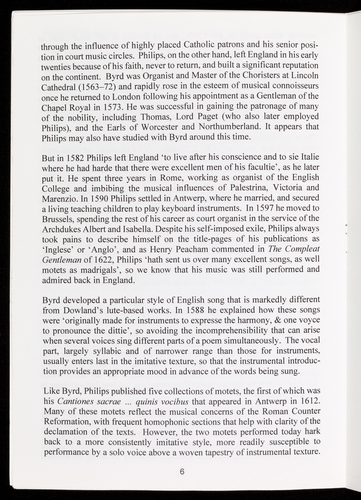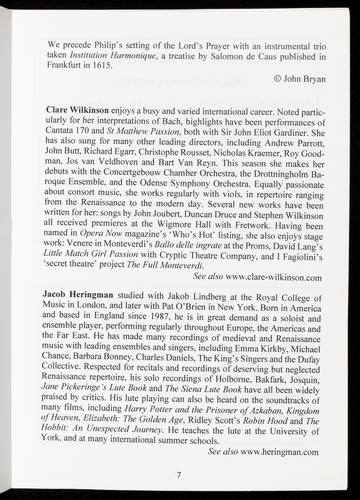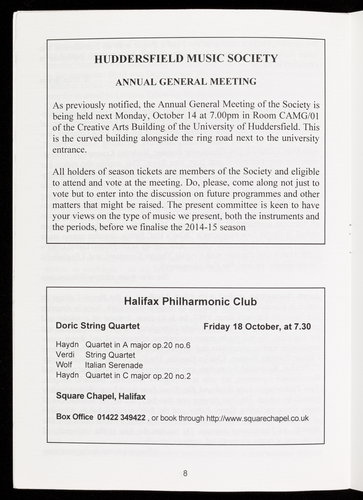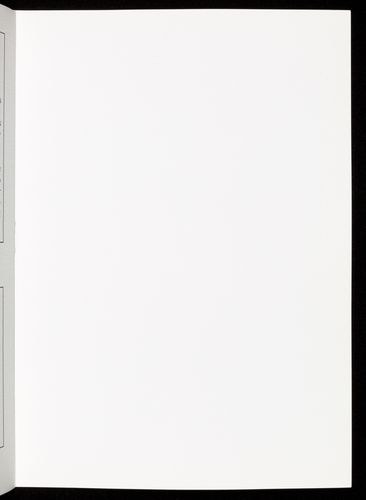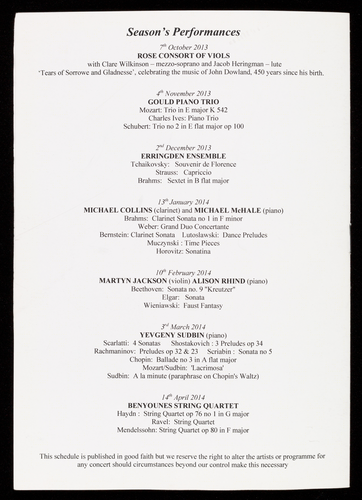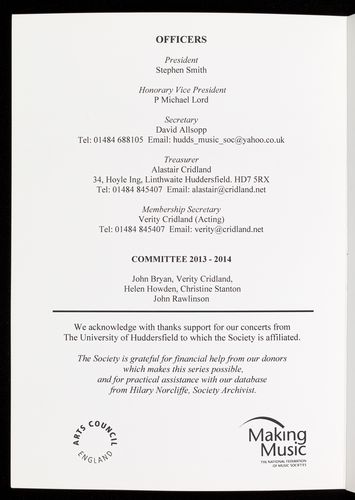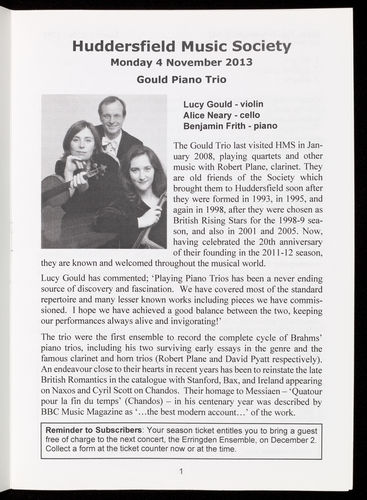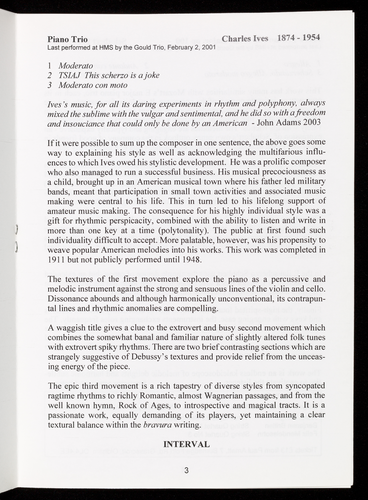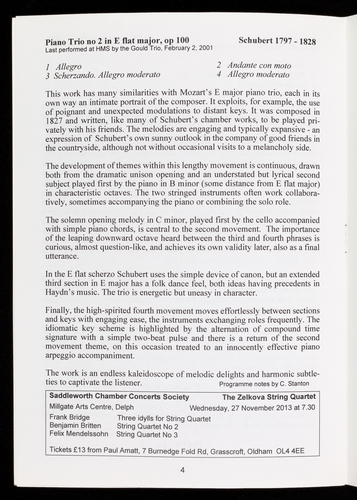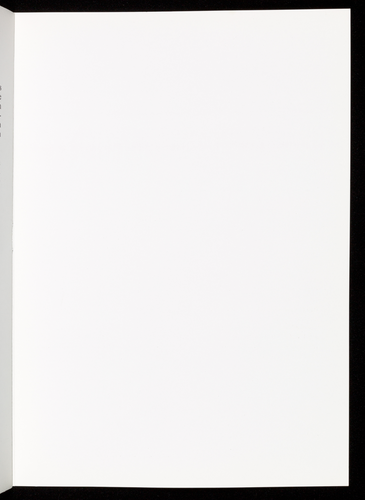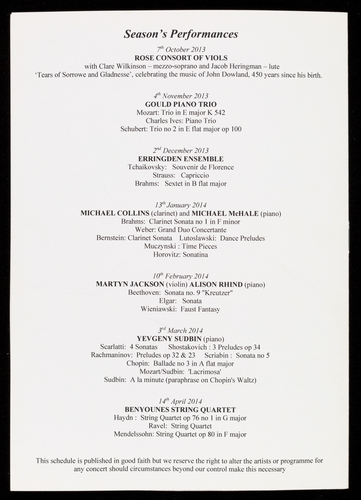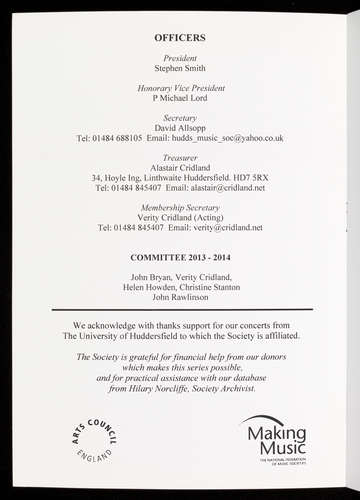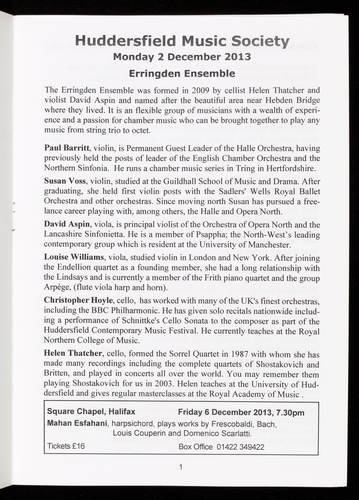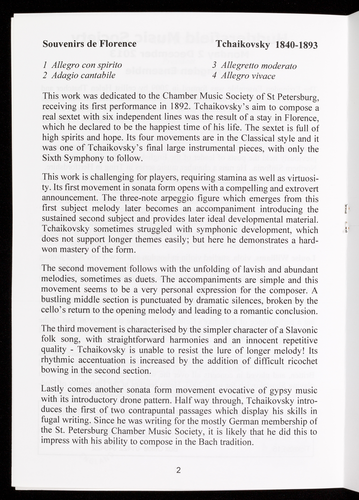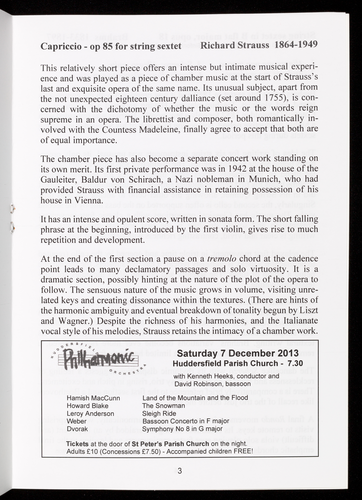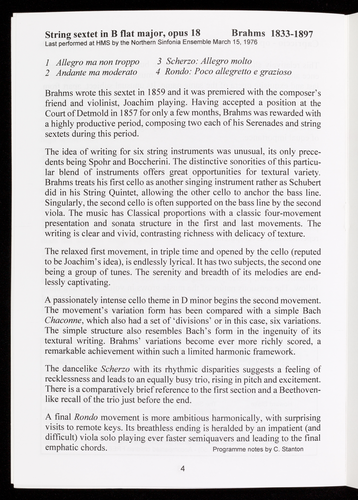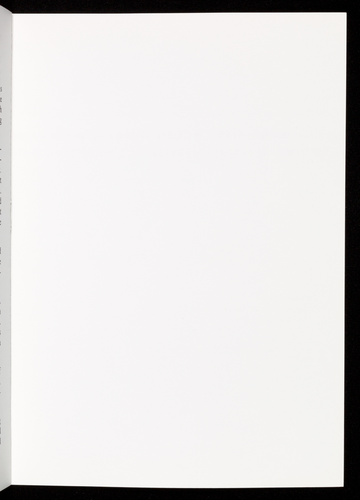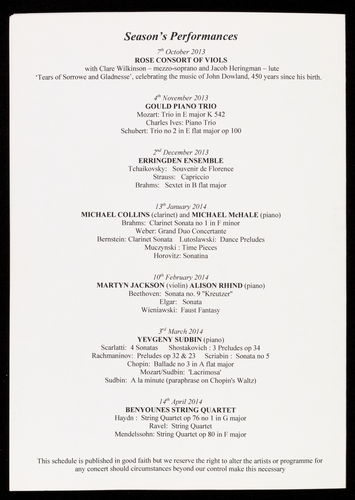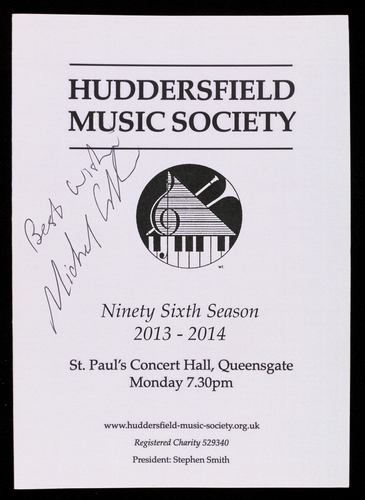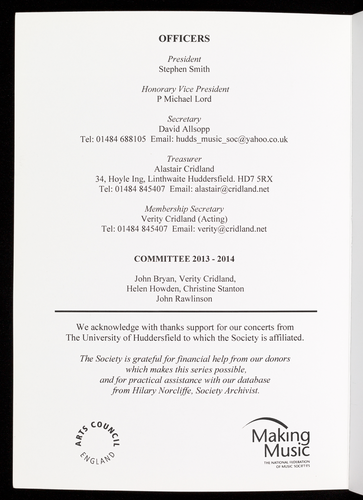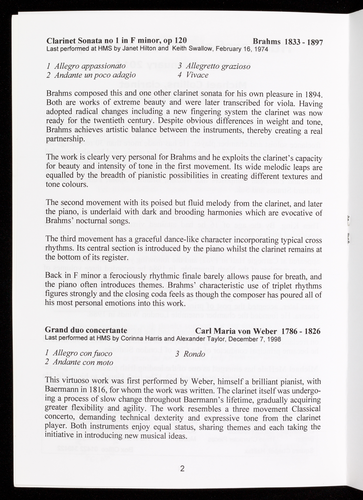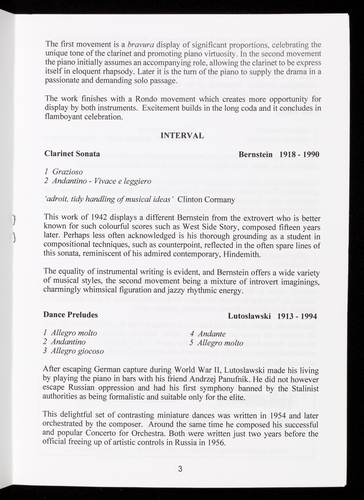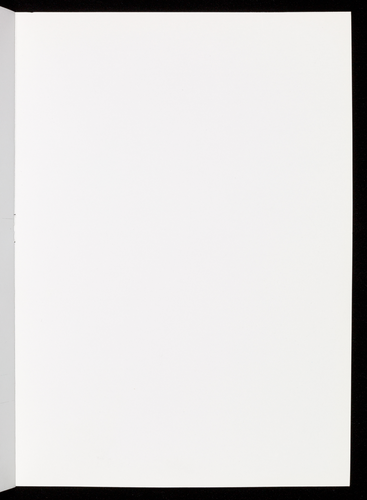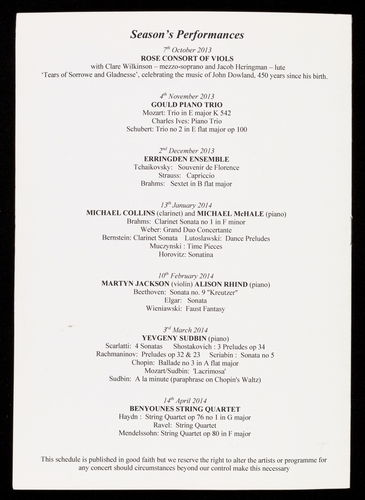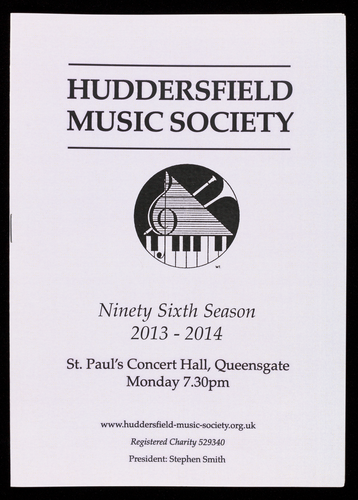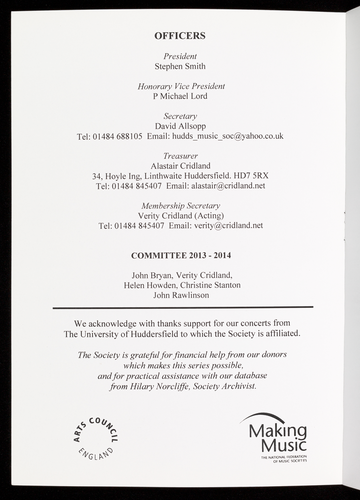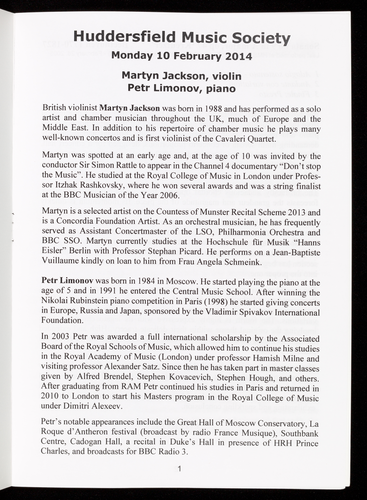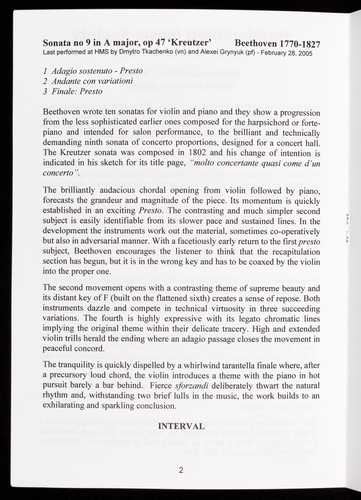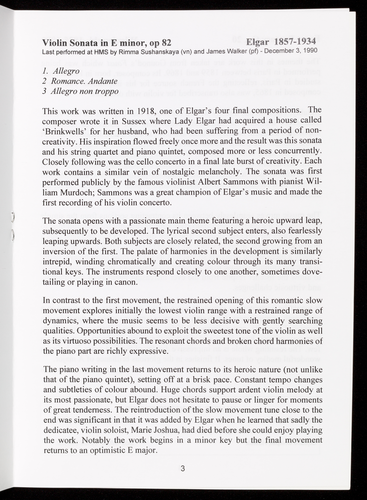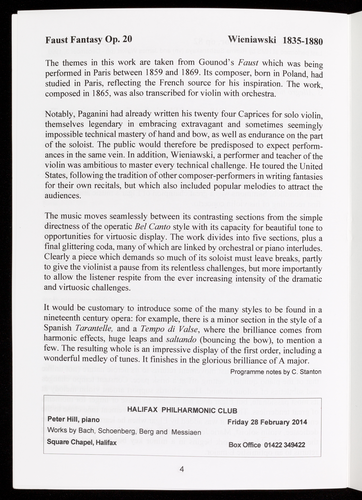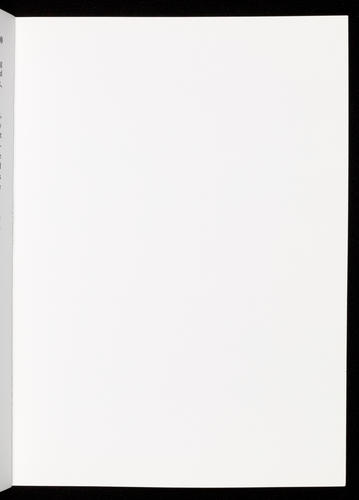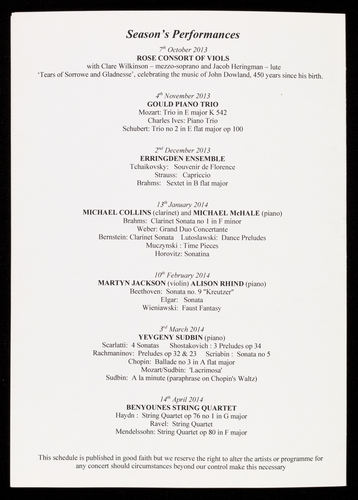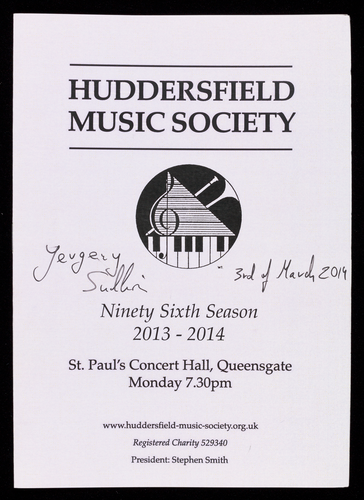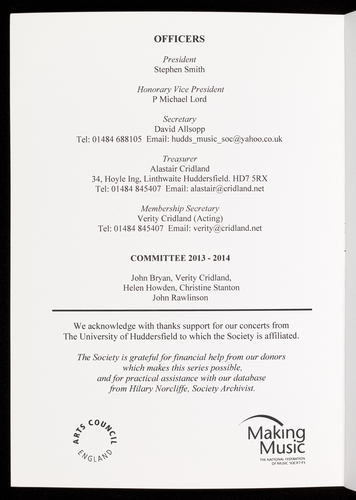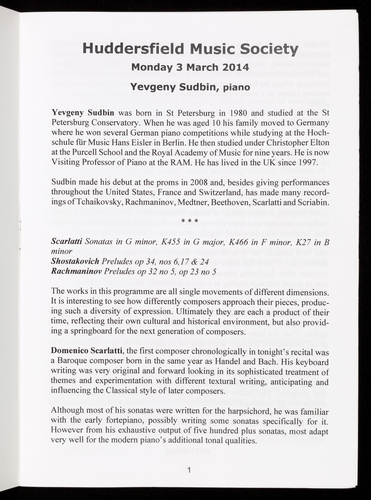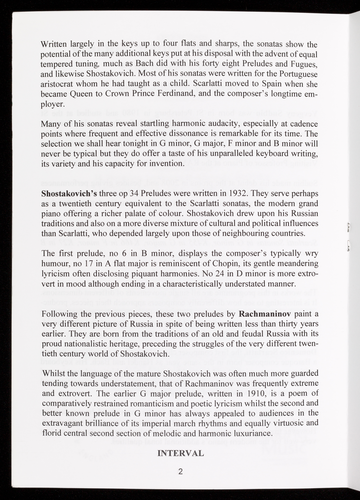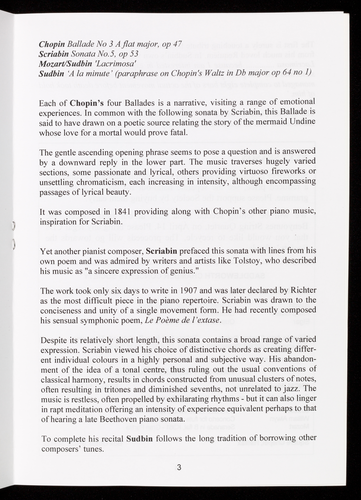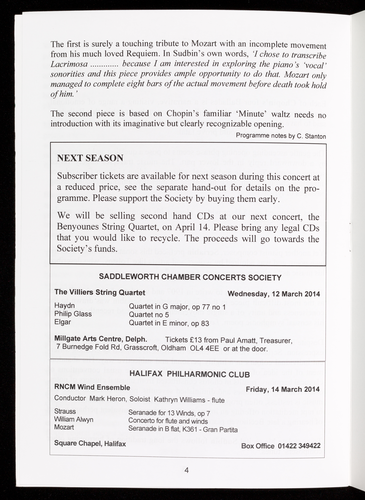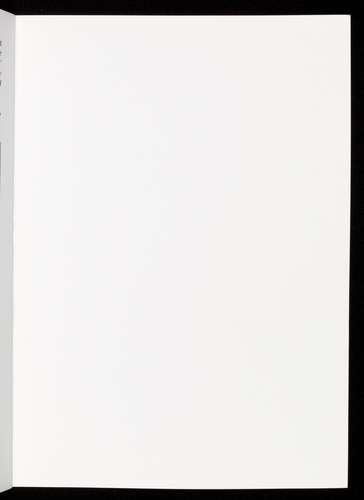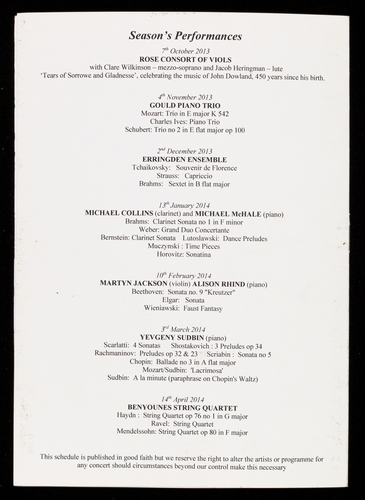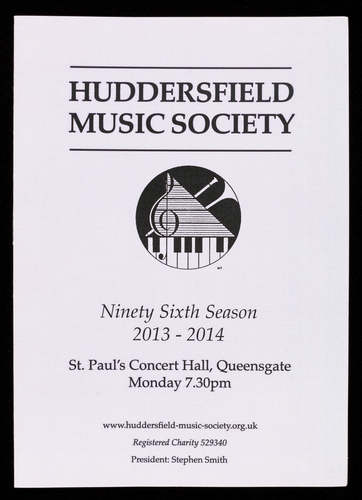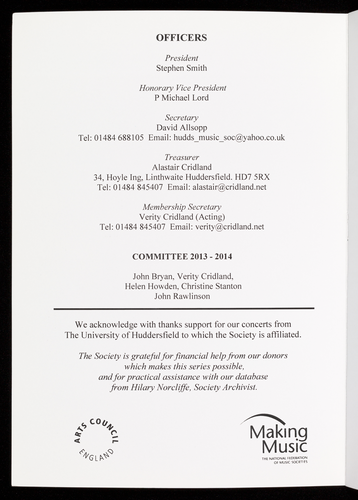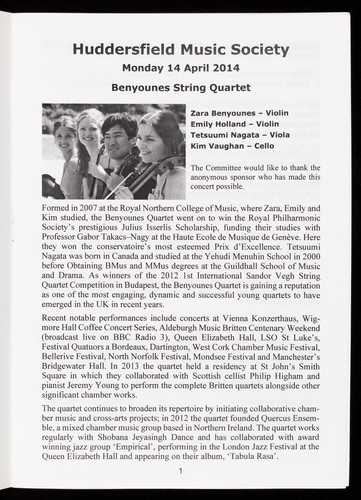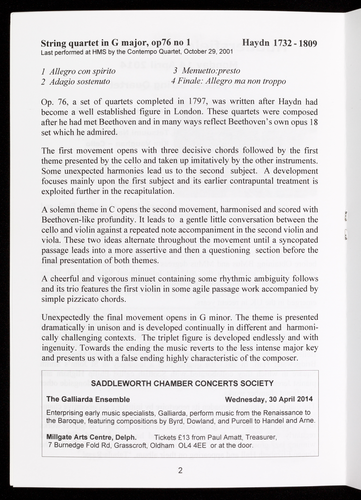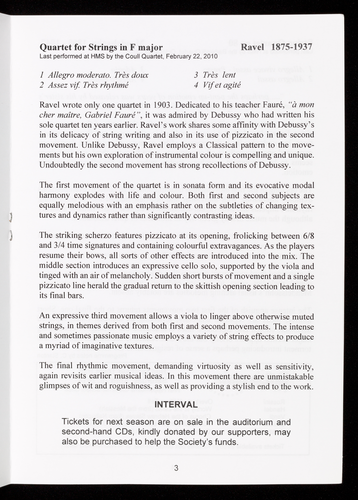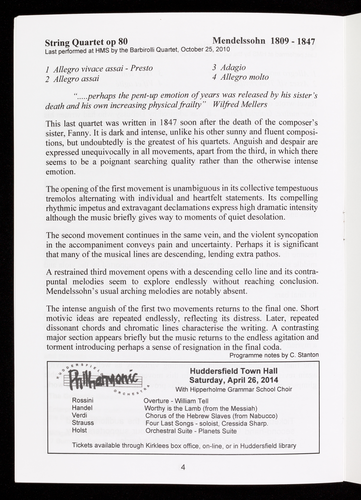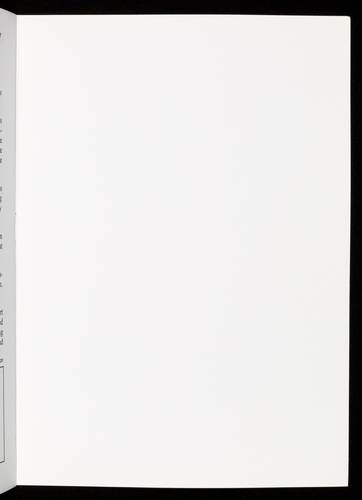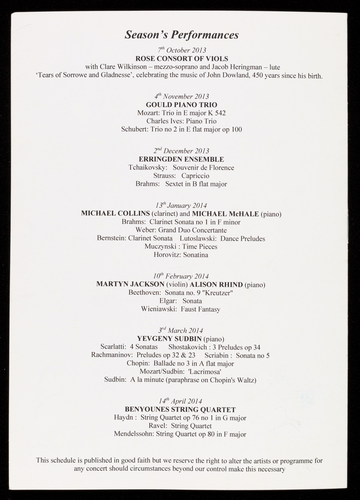Ocr'd Text:
HUDDERSFIELD
MUSIC SOCIETY
Ninety Sixth
Season
2013/14
St Paul's Hall, Huddersfield
All concerts start at 7.30 pm
Given in association with the
"Music at the University of Huddersfield"
Evening Concert Series
www.huddersfield-music-society.org.uk
Registered Charity 529340
President: Stephen Smith
Ocr'd Text:
Monday 7 October 2013
Rose Consort of Viols
with Clare Wilkinson - mezzo-soprano
and Jacob Heringman - lute
A welcome return by the Roses after five years
'Tears of Sorrowe and Gladnesse, celebrating the music
of John Dowland, 450 years since his birth. Music from
John Dowland's (1563-1626) intense collection of dance
music, Lachrimae, or Seaven Teares figured in seaven
Passionate Pavans, interspersed with some of his greatest
ayres and lute solos, set in the context of instrumental
fantasias, consort songs and Latin motets by two of his
great English contemporaries: William Byrd (c.1540-1623)
and Peter Philips (1561-1628).
Monday 4 November 2013
Gould Piano Trio
The return of an ensemble with an enviable reputation for
musical integrity and imagination
Mozart: Trio in E major K 542
Charles Ives: Piano Trio
Schubert: Trio no 2 in E flat major op 100
Ocr'd Text:
HUDDERSFIELD
MUSIC SOCIETY
Ninety Sixth
Season
2013/14
Booking form
(to be detached)
T
WI.
Ocr'd Text:
Monday 2 December 2013
Erringden Ensemble
A renowned ensemble from around
Hebden Bridge will be playing
as a string sextet
Tchaikovsky: Souvenir de Florence
Strauss: Capriccio
Brahms: Sextet in B flat major
Monday 13 January 2014
Michael Collins (clarinet) and
Michael McHale (piano)
Michael won the woodwind prize in the first BBC
Young Musician of the Year Competition, now
acknowledged as one of the world's finest clarinetists,
and returns to us after a long gap
Brahms: Clarinet Sonata no 1 in F minor op 120 no 1
Weber: Grand Duo Concertante
Bernstein: Clarinet Sonata
Lutoslawski: Dance Preludes
Muczynski: Time Pieces
Horovitz: Sonatina
Monday 10 February 2014
Martyn Jackson (violin)
Alison Rhind (piano)
A British violinist, Martyn has performed
throughout the UK, Europe and the Middle East
and is making his debut for HMS
Beethoven: Sonata in A major op 47 "Kreutzer"
Elgar: Sonata in E minor op 82
Wieniawski: Faust Fantasy
Monday 3 March 2014
Yevgeny Sudbin (piano)
Yevgeny Sudbin is already hailed as potentially one
of the greatest pianists of the 21st century
Scarlatti: 4 Sonatas
Shostakovich: 3 Preludes op 34
Rachmaninov: Selection of preludes
from op 32 & op 23
Scriabin: Sonata no 5
Chopin: Ballade no 3 in A flat major
Mozart/Sudbin: 'Lacrimosa'
Sudbin: A la minute (paraphrase on Chopin's Waltz)
Ocr'd Text:
Subscriber Ticket
Single Concert Ticket
Student Season Ticket
Single Student Ticket
Booking arrangements
Tickets may be obtained by using the booking form below or at the door.
for
1 Lingwood Close, New Mill, Holmfirth HD9 7NN.
Email: hudds_music_soc@yahoo.co.uk
TICKETS
Single concert tickets may be bought online using the link on our website
www.huddersfield-music-society.org.uk
Please send ............ subscriber tickets
Name
Post this form with cheque payable to
Huddersfield Music Society
Please send ............ single concert tickets
..........................
Address
Postcode
BOOKING FORM
I enclose cheque
£98
£18
£15
£3
..........
Telephone
Total £
......
(dates)
1 Lingwood Close, New Mill, Holmfirth HD9 7NN.
Monday 14 April 2014
Benyounes String Quartet
The Benyounes Quartet is rapidly emerging as
one of the most dynamic and engaging
young British string quartets
Haydn: String Quartet op 76 no 1 in G major
Ravel: String Quartet
Mendelssohn: String Quartet op 80 in F minor
We acknowledge with thanks support from
the University of Huddersfield
to which the Society is affiliated.
The Society is grateful for financial help from
our donors which makes this series
possible and for support from:
Making Music
(National Federation of Music Societies)
and the Countess of Munster Trust.
NB This brochure is published in good faith
but we reserve the right to alter the artists
or programme for any concert
should circumstances beyond our control
make this necessary.
Please check the Society's website
www.huddersfield-music-society.org.uk
Ocr'd Text:
Subscriber Ticket
Single Concert Ticket
Student Season Ticket
Single Student Ticket
Subscriber tickets may be obtained from
1 Lingwood Close, New Mill, Holmfirth HD9 7NN.
Email: hudds_music_soc@yahoo.co.uk
vougu
or on the door at the first concert.
Tickets for individual concerts can be obtained
at the door, as above or online using the link on
our website
TICKETS
www.huddersfield-music-society.org.uk
NORTH
e
TRINITY STREET
AIR MANCH
TO MANCHESTER
RAILWAY STATION
1008
00G00
007
BOA
OOU
2900
0080
£98
£18
£15
£3
CAR PARK
CHICCE Saro
TO WAKEFIELD
SHEFFIELD
Alisatieasies stry
ST. PAUL'S HALL
The car park is lit and attended.
Concerts usually end at about 9.30pm.
UNIVERSITY OF
HUDDERSFIELD
Car parking is available across Queensgate from
St Paul's for a small fee.
Ocr'd Text:
HUDDERSFIELD
MUSIC SOCIETY
WT.
Ninety Sixth Season
2013 - 2014
St. Paul's Concert Hall, Queensgate
Monday 7.30pm
www.huddersfield-music-society.org.uk
Registered Charity 529340
President: Stephen Smith
Ocr'd Text:
Hon. Secretary
David Allsopp
Tel: 01484 688105 Email: hudds_music_soc@yahoo.co.uk
OFFICERS
ARTS
President
Stephen Smith
COUNCIL
ENGLAND
Hon. Treasurer
P Michael Lord
Tel: 01484 310104
We acknowledge with thanks support for our concerts from
The University of Huddersfield to which the Society is affiliated.
COMMITTEE
John Bryan, Margaret Collison,
Alastair Cridland, Verity Cridland,
Helen Howden,, Christine Stanton
The Society is grateful for financial help from our donors
which makes this series possible,
and for practical assistance with our database
from Hilary Norcliffe, Society Archivist.
Making
Music
THE NATIONAL FEDERATION
OF MUSIC SOCIETIES
Ocr'd Text:
Huddersfield Music Society
Monday 7 October 2013
The RSE
Consort of Viols
Ibi Aziz, John Bryan, Andrew Kerr, Susanna Pell, Peter Wendland
with Clare Wilkinson mezzo-soprano
and Jacob Heringman lute
The Rose Consort of Viols takes its name from the celebrated family of viol
makers, whose work spanned the growth and flowering of the English
consort repertoire. The Consort performs extensively throughout the UK
and Europe, appears regularly on the BBC and in the major London concert
halls, and has also featured at festivals in Canada and the USA, and as a
guest ensemble at the Pan-Pacific Gamba Gathering in Hawaii. Concerts
have included guest soloists such as Emma Kirkby at HMS in October 2008;
the vocal groups Red Byrd, Stile Antico and the BBC Singers; and lutenists
Jakob Lindberg and Paul O'Dette. The Consort has received awards for its
research and performance of newly devised programmes, and has made a
number of highly acclaimed recordings, including most recently An Emer-
ald in a Work of Gold, featuring music by Byrd and his contemporaries.
Recent engagements have included performances at the BBC Proms 2012
with vocal ensemble Tenebrae; at the National Gallery in London; and for
Semana de Música Religiosa in Cuenca, Spain. Plans for later in 2013
include concerts at the Tudeley Festival, as well as the issue of a CD with
Clare Wilkinson of music by William Byrd and Peter Philips.
See also www.roseconsort.co.uk
Biographies of Clare Wilkinson and Jacob Heringman are on page 7
1
Ocr'd Text:
'Teares of Sorrowe and Gladnesse':
celebrating the music of John Dowland, 450 years since his birth
Lachrimae Antiquae
All ye whom Love or Fortune
Captaine Digorie Piper his Galiard
In Nomine No. 5
How vain the toils
Browning
Christianus the fourth, his Galliard
A shepherd in a shade
Trio in the first mode
Pater noster
M. Henry Noell his Galiard
Come again
Interval
M. John Langtons Pavan
The Earle of Essex, his Galliard
Wretched Albinus
Viae Sion lugent
Vezzosi augelli
Lasso vita mia
Susanne un jour
M. Bucton his Galiard
Susanna Galliard
Attollite portas
Tarleton's Riserrectione
Adoramus te Christe
Lachrimae Verae
2
John Dowland
Dowland
Dowland
William Byrd
Byrd
Byrd
Dowland
Dowland
Peter Philips
Philips mental
Dowland
Dowland
Dowland
Dowland
Byrd
Philips
Luca Marenzio
Dowland
Byrd
Dowland
Byrd
1563-1623
Dowland
c.1540-1623
1561-1628
Orlande de Lassus 1530-1594
Dowland
Dowland
1533-1599
Ocr'd Text:
Translations
Philips: Pater noster
Our Father, which art in heaven, hallowed be thy name; thy kingdom
come; thy will be done, in earth as it is in heaven. Give us this day our
daily bread. And forgive us our trespasses, as we forgive them that
trespass against us. And lead us not into temptation; but deliver us from
evil. Amen.
Philips: Viae Sion lugent
The ways of Zion do mourn, because none come to the solemn feasts: all
her gates are desolate: her priests sigh: her virgins are afflicted, and she
is in bitterness.
(Lamentations 1:4)
Dowland: Lasso vita mia
My unhappy Life, you are making me die.
Cruel love consumes my heart,
Inflicts a thousand wounds, which kill me.
Woe, alas, do not let me die,
Cruel Love makes me suffer a thousand martyrdoms.
Byrd: Attolite portas
Lift up your gates ye princes, and be ye lifted up O eternal gates: and the
King of glory shall enter in. Who is this King of glory? The Lord strong
and mighty, the Lord mighty in battle, the Lord of powers, he is the King
of glory. Glory be to the Father, and to the Son, and to the Holy Spirit:
as it was in the beginning, is now and ever shall be, world without end.
Amen.
(Psalm 23: 7, 8, 10)
Byrd: Adoramus te Christe
We adore thee, O Christ, and we bless thee: because by thy holy cross
thou hast redeemed the world.
3
Ocr'd Text:
Programme note
John Dowland, the 450th anniversary of whose birth we celebrate this year,
remains a shadowy figure. We learn most about him from the prefaces to his
publications, but these carefully produce his own self-fashioned image. His
predilection for melancholic poetry, his adoption of the Lachrimae pavan as
his personal emblem, and his many references to the slights he felt from his
contemporaries, give us a portrait of an unstable and perhaps 'romantic'
character. It is true that Dowland's career suggests that he was, unusually for
an Elizabethan musician, more attractive to continental employers than at
home. He travelled widely abroad and had to wait until 1612 to obtain the post
he had long coveted as one of the royal 'lewters'. But before then he had
established for himself something of a stellar career, with well-paid appoint-
ments at courts in Germany and for the King of Denmark. He clearly had
friends in high places: many of his songs set texts by Elizabethan noble
courtiers, some of whom acted as Dowland's patrons, and recent research
indicates that once he had returned to London around 1606 he was much in
demand playing for masques and teaching the lute to members of the elite
families.
Of his earlier career, we have only tantalising glimpses. There is no documen-
tary evidence of Dowland's place or date of birth, though in his 1612 A
Pilgrimes Solace he described himself as 'being now entered into the fiftieth
yeare of mine age'. We know nothing of his family background, upbringing
or musical training. But in 1580 he went as a servant to Sir Henry Cobham,
the Ambassador to the French court in Paris. It was almost certainly there that
Dowland would have encountered new French humanist poetry set to music
in the fashionable style of the air de cour, which prioritised clarity of verbal
expression and a directly melodic approach over the more complex polyph-
ony of contemporary English song. Was it also in Paris that he came across
Lassus's 'Susanne un jour'? First published in 1567 this was a world-wide
'hit' to which Dowland paid tribute in his 1604 dance collection: M. Buctons
Galiard begins, like the chanson, one part at a time using Lassus's distinctive
two-part counterpoint.
We next hear of Dowland in 1588, the year of the Spanish Armada, when he
received his Mus. Bac. from Oxford, along with Thomas Morley. In the early
1590s his music was heard at court, but in 1594 he failed to secure the place
in the Queen's music left unfilled on the death of John Johnson so he decided
to travel to Germany and Italy, seeking employment abroad but also with the
aim of learning the latest musical developments from the great madrigalist
Luca Marenzio in Rome. He visited Venice and Ferrara, both centres of the
4
Ocr'd Text:
8
J
musical avant garde in the 1590s, and performed at the ducal court in
Florence. But he never got as far as Rome, since, as we learn from a long and
at times rambling letter that he wrote to Sir Robert Cecil in 1595, he found
himself in the company of a group of potentially treacherous English Catho-
lics and was afraid he would tainted by association. Of all the Italian madri-
galists, it was Marenzio whose music was most popular in England. 'Lasso
vita mia' from Dowland's 1612 book shows his complete assimilation of the
latest Italian styles, incorporating the fashionable elements of chromaticism
and recitative, but with a curiously English addition of a descanting treble viol.
The next significant stage in Dowland's career took him in 1598 to a well-
paid position at the court of King Christian IV of Denmark, as enthusiastic
and lavish a patron of music as he was fond of hard drink. In 1603 Queen
Elizabeth was succeeded by James I, whose wife Anne was King Christian's
sister. Dowland's hopes of a court appointment in London must have been
raised by this turn of events, but despite shuttling back and forth from
De ark to England, publishing a further songbook and dedicating his
revolutionary set of five-part consort dances with lute to Queen Anne
(Dowland's preface states that he had accesse to your Highnesse at Winches-
ter' before publication), the English court appointment remained elusive and
he was passed over for a nonentity when the next vacancy occurred in 1610.
The latter part of Dowland's life was spent in performing and teaching,
contributing items to anthologies of psalms and devotional partsongs. His last
documented appearance was in the Consorte that played at the funeral solem-
nities of James I in 1625; his own death followed within the year.
Dowland's personification of himself as 'of the tears' was only a partial view.
Melancholy was not only fashionable amongst poets and musicians, but was
also seen as having a cathartic property. As Robert Burton's Anatomy of
Melancholy (Oxford, 1621) tells us, 'many men are melancholy by hearing
musicke, but it is a pleasant melancholy that it causeth... it expells cares,
alters their grieved mindes, and easeth in an instant.' This chimes with
Dowland's own preface to Lachrimae which 'doth promise teares, vnfit
guests in these ioyfull times, yet no doubt pleasant are the teares which
Musicke weepes, neither are teares shed alwayes in sorrowe, but sometime in
ioy and gladnesse."
The lives, careers and music of John Dowland, William Byrd and Peter
Philips have much in common, but also exhibit some significant differences.
While Dowland protested that he had relinquished his earlier Roman Catholic
faith, both Byrd and Philips staunchly maintained theirs. Byrd spent his entire
life in Protestant England as a recusant, narrowly avoiding persecution
5
Ocr'd Text:
through the influence of highly placed Catholic patrons and his senior posi-
tion in court music circles. Philips, on the other hand, left England in his early
twenties because of his faith, never to return, and built a significant reputation
on the continent. Byrd was Organist and Master of the Choristers at Lincoln
Cathedral (1563-72) and rapidly rose in the esteem of musical connoisseurs.
once he returned to London following his appointment as a Gentleman of the
Chapel Royal in 1573. He was successful in gaining the patronage of many
of the nobility, including Thomas, Lord Paget (who also later employed
Philips), and the Earls of Worcester and Northumberland. It appears that
Philips may also have studied with Byrd around this time.
But in 1582 Philips left England 'to live after his conscience and to sie Italie
where he had harde that there were excellent men of his facultie', as he later
put it. He spent three years in Rome, working as organist of the English
College and imbibing the musical influences of Palestrina, Victoria and
Marenzio. In 1590 Philips settled in Antwerp, where he married, and secured
a living teaching children to play keyboard instruments. In 1597 he moved to
Brussels, spending the rest of his career as court organist in the service of the
Archdukes Albert and Isabella. Despite his self-imposed exile, Philips always
took pains to describe himself on the title-pages of his publications as
'Inglese' or 'Anglo', and as Henry Peacham commented in The Compleat
Gentleman of 1622, Philips 'hath sent us over many excellent songs, as well
motets as madrigals', so we know that his music was still performed and
admired back in England.
Byrd developed a particular style of English song that is markedly different
from Dowland's lute-based works. In 1588 he explained how these songs
were 'originally made for instruments to expresse the harmony, & one voyce
to pronounce the dittie', so avoiding the incomprehensibility that can arise
when several voices sing different parts of a poem simultaneously. The vocal
part, largely syllabic and of narrower range than those for instruments,
usually enters last in the imitative texture, so that the instrumental introduc-
tion provides an appropriate mood in advance of the words being sung.
Like Byrd, Philips published five collections of motets, the first of which was
his Cantiones sacrae ... quinis vocibus that appeared in Antwerp in 1612.
Many of these motets reflect the musical concerns of the Roman Counter
Reformation, with frequent homophonic sections that help with clarity of the
declamation of the texts. However, the two motets performed today hark
back to a more consistently imitative style, more readily susceptible to
performance by a solo voice above a woven tapestry of instrumental texture.
6
Ocr'd Text:
We precede Philip's setting of the Lord's Prayer with an instrumental trio
taken Institution Harmonique, a treatise by Salomon de Caus published in
Frankfurt in 1615.
© John Bryan
Clare Wilkinson enjoys a busy and varied international career. Noted partic-
ularly for her interpretations of Bach, highlights have been performances of
Cantata 170 and St Matthew Passion, both with Sir John Eliot Gardiner. She
has also sung for many other leading directors, including Andrew Parrott,
John Butt, Richard Egarr, Christophe Rousset, Nicholas Kraemer, Roy Good-
man, Jos van Veldhoven and Bart Van Reyn. This season she makes her
debuts with the Concertgebouw Chamber Orchestra, the Drottningholm Ba-
roque Ensemble, and the Odense Symphony Orchestra. Equally passionate
about consort music, she works regularly with viols, in repertoire ranging
from the Renaissance to the modern day. Several new works have been
written for her: songs by John Joubert, Duncan Druce and Stephen Wilkinson
all received premieres at the Wigmore Hall with Fretwork. Having been
named in Opera Now magazine's 'Who's Hot' listing, she also enjoys stage
work: Venere in Monteverdi's Ballo delle ingrate at the Proms, David Lang's
Little Match Girl Passion with Cryptic Theatre Company, and I Fagiolini's
'secret theatre' project The Full Monteverdi.
See also www.clare-wilkinson.com
Jacob Heringman studied with Jakob Lindberg at the Royal College of
Music in London, and later with Pat O'Brien in New York. Born in America
and based in England since 1987, he is in great demand as a soloist and
ensemble player, performing regularly throughout Europe, the Americas and
the Far East. He has made many recordings of medieval and Renaissance
music with leading ensembles and singers, including Emma Kirkby, Michael
Chance, Barbara Bonney, Charles Daniels, The King's Singers and the Dufay
Collective. Respected for recitals and recordings of deserving but neglected
Renaissance repertoire, his solo recordings of Holborne, Bakfark, Josquin,
Jane Pickeringe's Lute Book and The Siena Lute Book have all been widely
praised by critics. His lute playing can also be heard on the soundtracks of
many films, including Harry Potter and the Prisoner of Azkaban, Kingdom
of Heaven, Elizabeth: The Golden Age, Ridley Scott's Robin Hood and The
Hobbit: An Unexpected Journey. He teaches the lute at the University of
York, and at many international summer schools.
See also www.heringman.com
7
Ocr'd Text:
HUDDERSFIELD MUSIC SOCIETY
ANNUAL GENERAL MEETING
As previously notified, the Annual General Meeting of the Society is
being held next Monday, October 14 at 7.00pm in Room CAMG/01
of the Creative Arts Building of the University of Huddersfield. This
is the curved building alongside the ring road next to the university
entrance.
All holders of season tickets are members of the Society and eligible
to attend and vote at the meeting. Do, please, come along not just to
vote but to enter into the discussion on future programmes and other
matters that might be raised. The present committee is keen to have
your views on the type of music we present, both the instruments and
the periods, before we finalise the 2014-15 season
Halifax Philharmonic Club
Doric String Quartet
Haydn Quartet in A major op.20 no.6
Verdi String Quartet
Wolf Italian Serenade
Haydn Quartet in C major op.20 no.2
Square Chapel, Halifax
Box Office 01422 349422, or book through http://www.squarechapel.co.uk
8
Friday 18 October, at 7.30
Ocr'd Text:
Season's Performances
7th October 2013
ROSE CONSORT OF VIOLS
with Clare Wilkinson - mezzo-soprano and Jacob Heringman – lute
'Tears of Sorrowe and Gladnesse', celebrating the music of John Dowland, 450 years since his birth.
4th November 2013
GOULD PIANO TRIO
Mozart: Trio in E major K 542
Charles Ives: Piano Trio
Schubert: Trio no 2 in E flat major op 100
2nd December 2013
ERRINGDEN ENSEMBLE
Tchaikovsky: Souvenir de Florence
Strauss: Capriccio
Brahms: Sextet in B flat major
13th January 2014
MICHAEL COLLINS (clarinet) and MICHAEL MCHALE (piano)
Brahms: Clarinet Sonata no 1 in F minor
Weber: Grand Duo Concertante
Bernstein: Clarinet Sonata Lutoslawski: Dance Preludes
Muczynski: Time Pieces
Horovitz: Sonatina
10th February 2014
MARTYN JACKSON (violin) ALISON RHIND (piano)
Beethoven: Sonata no. 9 "Kreutzer"
Elgar: Sonata
Wieniawski: Faust Fantasy
3rd March 2014
YEVGENY SUDBIN (piano)
Scarlatti: 4 Sonatas
Shostakovich: 3 Preludes op 34
Rachmaninov: Preludes op 32 & 23 Scriabin: Sonata no 5
Chopin: Ballade no 3 in A flat major
Mozart/Sudbin: 'Lacrimosa'
Sudbin: A la minute (paraphrase on Chopin's Waltz)
14th April 2014
BENYOUNES STRING QUARTET
Haydn: String Quartet op 76 no 1 in G major
Ravel: String Quartet
Mendelssohn: String Quartet op 80 in F major
This schedule is published in good faith but we reserve the right to alter the artists or programme for
any concert should circumstances beyond our control make this necessary
Ocr'd Text:
HUDDERSFIELD
MUSIC SOCIETY
WT.
Ninety Sixth Season
2013-2014
St. Paul's Concert Hall, Queensgate
Monday 7.30pm
www.huddersfield-music-society.org.uk
Registered Charity 529340
President: Stephen Smith
Ocr'd Text:
OFFICERS
Secretary
David Allsopp
Tel: 01484 688105 Email: hudds_music_soc@yahoo.co.uk
TS
President
Stephen Smith
Honorary Vice President
P Michael Lord
Alastair Cridland
34, Hoyle Ing, Linthwaite Huddersfield. HD7 5RX
Tel: 01484 845407 Email: alastair@cridland.net
Treasurer
Membership Secretary
Verity Cridland (Acting)
Tel: 01484 845407 Email: verity@cridland.net
ENGLAND
COUNCIL
COMMITTEE 2013 - 2014
We acknowledge with thanks support for our concerts from
The University of Huddersfield to which the Society is affiliated.
John Bryan, Verity Cridland,
Helen Howden, Christine Stanton
John Rawlinson
The Society is grateful for financial help from our donors
which makes this series possible,
and for practical assistance with our database
from Hilary Norcliffe, Society Archivist.
Making
Music
THE NATIONAL FEDERATION
OF MUSIC SOCIETIES
Ocr'd Text:
Huddersfield Music Society
Monday 4 November 2013
Gould Piano Trio
Lucy Gould - violin
Alice Neary-cello
Benjamin Frith - piano
The Gould Trio last visited HMS in Jan-
uary 2008, playing quartets and other
music with Robert Plane, clarinet. They
are old friends of the Society which
brought them to Huddersfield soon after
they were formed in 1993, in 1995, and
again in 1998, after they were chosen as
British Rising Stars for the 1998-9 sea-
son, and also in 2001 and 2005. Now,
having celebrated the 20th anniversary
of their founding in the 2011-12 season,
they are known and welcomed throughout the musical world.
Lucy Gould has commented; 'Playing Piano Trios has been a never ending
source of discovery and fascination. We have covered most of the standard
repertoire and many lesser known works including pieces we have commis-
sioned. I hope we have achieved a good balance between the two, keeping
our performances always alive and invigorating!'
The trio were the first ensemble to record the complete cycle of Brahms'
piano trios, including his two surviving early essays in the genre and the
famous clarinet and horn trios (Robert Plane and David Pyatt respectively).
An endeavour close to their hearts in recent years has been to reinstate the late
British Romantics in the catalogue with Stanford, Bax, and Ireland appearing
on Naxos and Cyril Scott on Chandos. Their homage to Messiaen - 'Quatour
pour la fin du temps' (Chandos) - in his centenary year was described by
BBC Music Magazine as ...the best modern account...' of the work.
Reminder to Subscribers: Your season ticket entitles you to bring a guest
free of charge to the next concert, the Erringden Ensemble, on December 2.
Collect a form at the ticket counter now or at the time.
1
Ocr'd Text:
Piano Trio in E major, K 542
Last performed at HMS by the Gould Trio, October 2, 1995
1 Allegro
2 Andante grazioso
3 Allegro
Completed in 1788 with two others, this is one of Mozart's greatest piano trios.
All six were written during a period between 1784 and 1788, when he had
achieved success as a performer and composer of thirteen piano concertos.
Their elegant Classical style is mirrored in the piano trios and they were written
originally for the silvery toned fortepiano which was an ideal partner for the two
stringed instruments. E major is a rare choice of key for Mozart and seems
tinged with a wistfulness. The modulation into remote keys is a device more
commonly associated with Schubert, especially in the final movement.
The artless simplicity of the downward chromatic phrase introduced by the
piano becomes the subject of much skillful development. The more lyrical
second subject is led by the violin and the composer achieves characteristic
balance between the instruments within contrapuntal and harmonic framework.
Fine passage work is recollective of the composer's piano concertos.
Mozart 1756-1791
A second movement marked andante grazioso begins with a reflective two-part
A major theme from the piano, presented first alone, then enriched by alluring
counterpoint from the violin and cello. The minor middle section where the
piano assumes an accompanying role to the extensive violin melody is based
upon the initial theme.
The inspired and brilliant finale has a recurring rondo theme, suddenly intro-
ducing brilliant triplet passages for the violin, with which the piano appears to
compete by answering with even faster semiquaver passages. The movement is
enhanced by the adeptness of its sudden key shifts which are balanced and
matched by the perfect transparency of its textures.
Philharmonic
Rossini
Elgar
Tchaikovsky
ORCHEST
Saturday 9 November 2013
Huddersfield Town Hall - 7.30
Overture to "The Barber of Seville"
Cello concerto in E minor
Symphony No 6 in E minor, "Pathétique"
A concert of favourite works to open the season including one of Elgar's last and most famous
works played by the BBC's 2012 Young Musician of the Year, Laura van der Heijden.
Tickets available from: Huddersfield Library, Wakefield Town Hall, or at the door.
2
Ocr'd Text:
Ĵ
J
Piano Trio
Last performed at HMS by the Gould Trio, February 2, 2001
1 Moderato
2 TSIAJ This scherzo is a joke
3 Moderato con moto
Ives's music, for all its daring experiments in rhythm and polyphony, always
mixed the sublime with the vulgar and sentimental, and he did so with a freedom
and insouciance that could only be done by an American - John Adams 2003
Charles Ives 1874-1954
If it were possible to sum up the composer in one sentence, the above goes some
way to explaining his style as well as acknowledging the multifarious influ-
ences to which Ives owed his stylistic development. He was a prolific composer
who also managed to run a successful business. His musical precociousness as
a child, brought up in an American musical town where his father led military
bands, meant that participation in small town activities and associated music
making were central to his life. This in turn led to his lifelong support of
amateur music making. The consequence for his highly individual style was a
gift for rhythmic perspicacity, combined with the ability to listen and write in
more than one key at a time (polytonality). The public at first found such
individuality difficult to accept. More palatable, however, was his propensity to
weave popular American melodies into his works. This work was completed in
1911 but not publicly performed until 1948.
The textures of the first movement explore the piano as a percussive and
melodic instrument against the strong and sensuous lines of the violin and cello.
Dissonance abounds and although harmonically unconventional, its contrapun-
tal lines and rhythmic anomalies are compelling.
A waggish title gives a clue to the extrovert and busy second movement which
combines the somewhat banal and familiar nature of slightly altered folk tunes
with extrovert spiky rhythms. There are two brief contrasting sections which are
strangely suggestive of Debussy's textures and provide relief from the unceas-
ing energy of the piece.
The epic third movement is a rich tapestry of diverse styles from syncopated
ragtime rhythms to richly Romantic, almost Wagnerian passages, and from the
well known hymn, Rock of Ages, to introspective and magical tracts. It is a
passionate work, equally demanding of its players, yet maintaining a clear
textural balance within the bravura writing.
INTERVAL
3
Ocr'd Text:
Piano Trio no 2 in E flat major, op 100
Last performed at HMS by the Gould Trio, February 2, 2001
1 Allegro
3 Scherzando. Allegro moderato
Schubert 1797 - 1828
2 Andante con moto
4 Allegro moderato
This work has many similarities with Mozart's E major piano trio, each in its
own way an intimate portrait of the composer. It exploits, for example, the use
of poignant and unexpected modulations to distant keys. It was composed in
1827 and written, like many of Schubert's chamber works, to be played pri-
vately with his friends. The melodies are engaging and typically expansive - an
expression of Schubert's own sunny outlook in the company of good friends in
the countryside, although not without occasional visits to a melancholy side.
The development of themes within this lengthy movement is continuous, drawn
both from the dramatic unison opening and an understated but lyrical second
subject played first by the piano in B minor (some distance from E flat major)
in characteristic octaves. The two stringed instruments often work collabora-
tively, sometimes accompanying the piano or combining the solo role.
The solemn opening melody in C minor, played first by the cello accompanied
with simple piano chords, is central to the second movement. The importance
of the leaping downward octave heard between the third and fourth phrases is
curious, almost question-like, and achieves its own validity later, also as a final
utterance.
In the E flat scherzo Schubert uses the simple device of canon, but an extended
third section in E major has a folk dance feel, both ideas having precedents in
Haydn's music. The trio is energetic but uneasy in character.
Finally, the high-spirited fourth movement moves effortlessly between sections
and keys with engaging ease, the instruments exchanging roles frequently. The
idiomatic key scheme is highlighted by the alternation of compound time
signature with a simple two-beat pulse and there is a return of the second
movement theme, on this occasion treated to an innocently effective piano
arpeggio accompaniment.
The work is an endless kaleidoscope of melodic delights and harmonic subtle-
ties to captivate the listener.
Programme notes by C. Stanton
Saddleworth Chamber Concerts Society
4
The Zelkova String Quartet
Wednesday, 27 November 2013 at 7.30
Millgate Arts Centre, Delph
Frank Bridge
Three idylls for String Quartet
Benjamin Britten
String Quartet No 2
Felix Mendelssohn String Quartet No 3
Tickets £13 from Paul Amatt, 7 Burnedge Fold Rd, Grasscroft, Oldham OL4 4EE
Ocr'd Text:
Season's Performances
7th October 2013
ROSE CONSORT OF VIOLS
with Clare Wilkinson - mezzo-soprano and Jacob Heringman – lute
'Tears of Sorrowe and Gladnesse', celebrating the music of John Dowland, 450 years since his birth.
4th November 2013
GOULD PIANO TRIO
Mozart: Trio in E major K 542
Charles Ives: Piano Trio
Schubert: Trio no 2 in E flat major op 100
2nd December 2013
ERRINGDEN ENSEMBLE
Tchaikovsky: Souvenir de Florence
Strauss: Capriccio
Brahms: Sextet in B flat major
13th January 2014
MICHAEL COLLINS (clarinet) and MICHAEL MCHALE (piano)
Brahms: Clarinet Sonata no 1 in F minor
Weber: Grand Duo Concertante
Bernstein: Clarinet Sonata Lutoslawski: Dance Preludes
Muczynski: Time Pieces
Horovitz: Sonatina
10th February 2014
MARTYN JACKSON (violin) ALISON RHIND (piano)
Beethoven: Sonata no. 9 "Kreutzer"
Elgar: Sonata
Wieniawski: Faust Fantasy
3rd March 2014
YEVGENY SUDBIN (piano)
Scarlatti: 4 Sonatas
Shostakovich: 3 Preludes op 34
Rachmaninov: Preludes op 32 & 23 Scriabin: Sonata no 5
Chopin: Ballade no 3 in A flat major
Mozart/Sudbin: 'Lacrimosa'
Sudbin: A la minute (paraphrase on Chopin's Waltz)
14th April 2014
BENYOUNES STRING QUARTET
Haydn: String Quartet op 76 no 1 in G major
Ravel: String Quartet
Mendelssohn: String Quartet op 80 in F major
This schedule is published in good faith but we reserve the right to alter the artists or programme for
any concert should circumstances beyond our control make this necessary
Ocr'd Text:
HUDDERSFIELD
MUSIC SOCIETY
UL.
WT.
Ninety Sixth Season
2013-2014
St. Paul's Concert Hall, Queensgate
Monday 7.30pm
www.huddersfield-music-society.org.uk
Registered Charity 529340
President: Stephen Smith
Ocr'd Text:
OFFICERS
Secretary
David Allsopp
Tel: 01484 688105 Email: hudds_music_soc@yahoo.co.uk
TS
President
Stephen Smith
Honorary Vice President
P Michael Lord
Treasurer
Alastair Cridland
34, Hoyle Ing, Linthwaite Huddersfield. HD7 5RX
Tel: 01484 845407 Email: alastair@cridland.net
Membership Secretary
Verity Cridland (Acting)
Tel: 01484 845407 Email: verity@cridland.net
ENGLAND
COMMITTEE 2013 - 2014
We acknowledge with thanks support for our concerts from
The University of Huddersfield to which the Society is affiliated.
COUNCIL
John Bryan, Verity Cridland,
Helen Howden, Christine Stanton
John Rawlinson
The Society is grateful for financial help from our donors
which makes this series possible,
and for practical assistance with our database
from Hilary Norcliffe, Society Archivist.
Making
Music
THE NATIONAL FEDERATION
OF MUSIC SOCIETIES
Ocr'd Text:
Huddersfield Music Society
Monday 2 December 2013
Erringden Ensemble
The Erringden Ensemble was formed in 2009 by cellist Helen Thatcher and
violist David Aspin and named after the beautiful area near Hebden Bridge
where they lived. It is an flexible group of musicians with a wealth of experi-
ence and a passion for chamber music who can be brought together to play any
music from string trio to octet.
Paul Barritt, violin, is Permanent Guest Leader of the Halle Orchestra, having
previously held the posts of leader of the English Chamber Orchestra and the
Northern Sinfonia. He runs a chamber music series in Tring in Hertfordshire.
Susan Voss, violin, studied at the Guildhall School of Music and Drama. After
graduating, she held first violin posts with the Sadlers' Wells Royal Ballet
Orchestra and other orchestras. Since moving north Susan has pursued a free-
lance career playing with, among others, the Halle and Opera North.
David Aspin, viola, is principal violist of the Orchestra of Opera North and the
Lancashire Sinfonietta. He is a member of Psappha; the North-West's leading
contemporary group which is resident at the University of Manchester.
Louise Williams, viola, studied violin in London and New York. After joining
the Endellion quartet as a founding member, she had a long relationship with
the Lindsays and is currently a member of the Frith piano quartet and the group
Arpège, (flute viola harp and horn).
Christopher Hoyle, cello, has worked with many of the UK's finest orchestras,
including the BBC Philharmonic. He has given solo recitals nationwide includ-
ing a performance of Schnittke's Cello Sonata to the composer as part of the
Huddersfield Contemporary Music Festival. He currently teaches at the Royal
Northern College of Music.
Helen Thatcher, cello, formed the Sorrel Quartet in 1987 with whom she has
made many recordings including the complete quartets of Shostakovich and
Britten, and played in concerts all over the world. You may remember them
playing Shostakovich for us in 2003. Helen teaches at the University of Hud-
dersfield and gives regular masterclasses at the Royal Academy of Music.
Square Chapel, Halifax
Friday 6 December 2013, 7.30pm
Mahan Esfahani, harpsichord, plays works by Frescobaldi, Bach,
Louis Couperin and Domenico Scarlatti.
Box Office 01422 349422
Tickets £16
1
Ocr'd Text:
Souvenirs de Florence
1 Allegro con spirito
2 Adagio cantabile
Tchaikovsky 1840-1893
3 Allegretto moderato
4 Allegro vivace
This work was dedicated to the Chamber Music Society of St Petersburg,
receiving its first performance in 1892. Tchaikovsky's aim to compose a
real sextet with six independent lines was the result of a stay in Florence,
which he declared to be the happiest time of his life. The sextet is full of
high spirits and hope. Its four movements are in the Classical style and it
was one of Tchaikovsky's final large instrumental pieces, with only the
Sixth Symphony to follow.
This work is challenging for players, requiring stamina as well as virtuosi-
ty. Its first movement in sonata form opens with a compelling and extrovert
announcement. The three-note arpeggio figure which emerges from this
first subject melody later becomes an accompaniment introducing the
sustained second subject and provides later ideal developmental material.
Tchaikovsky sometimes struggled with symphonic development, which
does not support longer themes easily; but here he demonstrates a hard-
won mastery of the form.
The second movement follows with the unfolding of lavish and abundant
melodies, sometimes as duets. The accompaniments are simple and this
movement seems to be a very personal expression for the composer. A
bustling middle section is punctuated by dramatic silences, broken by the
cello's return to the opening melody and leading to a romantic conclusion.
The third movement is characterised by the simpler character of a Slavonic
folk song, with straightforward harmonies and an innocent repetitive
quality - Tchaikovsky is unable to resist the lure of longer melody! Its
rhythmic accentuation is increased by the addition of difficult ricochet
bowing in the second section.
Lastly comes another sonata form movement evocative of gypsy music
with its introductory drone pattern. Half way through, Tchaikovsky intro-
duces the first of two contrapuntal passages which display his skills in
fugal writing. Since he was writing for the mostly German membership of
the St. Petersburg Chamber Music Society, it is likely that he did this to
impress with his ability to compose in the Bach tradition.
2
Ocr'd Text:
Capriccio - op 85 for string sextet Richard Strauss 1864-1949
This relatively short piece offers an intense but intimate musical experi-
ence and was played as a piece of chamber music at the start of Strauss's
last and exquisite opera of the same name. Its unusual subject, apart from
the not unexpected eighteen century dalliance (set around 1755), is con-
cerned with the dichotomy of whether the music or the words reign
supreme in an opera. The librettist and composer, both romantically in-
volved with the Countess Madeleine, finally agree to accept that both are
of equal importance.
The chamber piece has also become a separate concert work standing on
its own merit. Its first private performance was in 1942 at the house of the
Gauleiter, Baldur von Schirach, a Nazi nobleman in Munich, who had
provided Strauss with financial assistance in retaining possession of his
house in Vienna.
It has an intense and opulent score, written in sonata form. The short falling
phrase at the beginning, introduced by the first violin, gives rise to much
repetition and development.
At the end of the first section a pause on a tremolo chord at the cadence
point leads to many declamatory passages and solo virtuosity. It is a
dramatic section, possibly hinting at the nature of the plot of the opera to
follow. The sensuous nature of the music grows in volume, visiting unre-
lated keys and creating dissonance within the textures. (There are hints of
the harmonic ambiguity and eventual breakdown of tonality begun by Liszt
and Wagner.) Despite the richness of his harmonies, and the Italianate
vocal style of his melodies, Strauss retains the intimacy of a chamber work.
Philharmonic
RCHESTR
Hamish MacCunn
Howard Blake
Leroy Anderson
Weber
Dvorak
Saturday 7 December 2013 me
Huddersfield Parish Church - 7.30
with Kenneth Heeks, conductor and
David Robinson, bassoon
Land of the Mountain and the Flood
The Snowman
Sleigh Ride
Bassoon Concerto in F major
Symphony No 8 in G major
Tickets at the door of St Peter's Parish Church on the night.
non Adults £10 (Concessions £7.50) - Accompanied children FREE! bodo pitadame
3
Ocr'd Text:
String sextet in B flat major, opus 18
Last performed at HMS by the Northern Sinfonia Ensemble March 15, 1976
1 Allegro ma non troppo
2 Andante ma moderato
Brahms 1833-1897
3 Scherzo: Allegro molto
4 Rondo: Poco allegretto e grazioso
Brahms wrote this sextet in 1859 and it was premiered with the composer's
friend and violinist, Joachim playing. Having accepted a position at the
Court of Detmold in 1857 for only a few months, Brahms was rewarded with
a highly productive period, composing two each of his Serenades and string
sextets during this period.
The idea of writing for six string instruments was unusual, its only prece-
dents being Spohr and Boccherini. The distinctive sonorities of this particu-
lar blend of instruments offers great opportunities for textural variety.
Brahms treats his first cello as another singing instrument rather as Schubert
did in his String Quintet, allowing the other cello to anchor the bass line.
Singularly, the second cello is often supported on the bass line by the second
viola. The music has Classical proportions with a classic four-movement
presentation and sonata structure in the first and last movements. The
writing is clear and vivid, contrasting richness with delicacy of texture.
The relaxed first movement, in triple time and opened by the cello (reputed
to be Joachim's idea), is endlessly lyrical. It has two subjects, the second one
being a group of tunes. The serenity and breadth of its melodies are end-
lessly captivating.
A passionately intense cello theme in D minor begins the second movement.
The movement's variation form has been compared with a simple Bach
Chaconne, which also had a set of 'divisions' or in this case, six variations.
The simple structure also resembles Bach's form in the ingenuity of its
textural writing. Brahms' variations become ever more richly scored, a
remarkable achievement within such a limited harmonic framework.
The dancelike Scherzo with its rhythmic disparities suggests a feeling of
recklessness and leads to an equally busy trio, rising in pitch and excitement.
There is a comparatively brief reference to the first section and a Beethoven-
like recall of the trio just before the end.
A final Rondo movement is more ambitious harmonically, with surprising
visits to remote keys. Its breathless ending is heralded by an impatient (and
difficult) viola solo playing ever faster semiquavers and leading to the final
emphatic chords.
Programme notes by C. Stanton
4
Ocr'd Text:
Season's Performances
7th October 2013
ROSE CONSORT OF VIOLS
with Clare Wilkinson - mezzo-soprano and Jacob Heringman - lute
'Tears of Sorrowe and Gladnesse', celebrating the music of John Dowland, 450 years since his birth.
4th November 2013
GOULD PIANO TRIO
Mozart: Trio in E major K 542
Charles Ives: Piano Trio
Schubert: Trio no 2 in E flat major op 100
2nd December 2013
ERRINGDEN ENSEMBLE
Tchaikovsky: Souvenir de Florence
Strauss: Capriccio
Brahms: Sextet in B flat major
13th January 2014
MICHAEL COLLINS (clarinet) and MICHAEL MCHALE (piano)
Brahms: Clarinet Sonata no 1 in F minor
Weber: Grand Duo Concertante
Bernstein: Clarinet Sonata Lutoslawski: Dance Preludes
Muczynski: Time Pieces
Horovitz: Sonatina
10th February 2014
MARTYN JACKSON (violin) ALISON RHIND (piano)
Beethoven: Sonata no. 9 "Kreutzer"
Elgar: Sonata
Wieniawski: Faust Fantasy
3rd March 2014
YEVGENY SUDBIN (piano)
Scarlatti: 4 Sonatas
Shostakovich: 3 Preludes op 34
Rachmaninov: Preludes op 32 & 23 Scriabin: Sonata no 5
Chopin: Ballade no 3 in A flat major
Mozart/Sudbin: 'Lacrimosa'
Sudbin: A la minute (paraphrase on Chopin's Waltz)
14th April 2014
BENYOUNES STRING QUARTET
Haydn: String Quartet op 76 no 1 in G major
Ravel: String Quartet
Mendelssohn: String Quartet op 80 in F major
This schedule is published in good faith but we reserve the right to alter the artists or programme for
any concert should circumstances beyond our control make this necessary
Ocr'd Text:
HUDDERSFIELD
MUSIC SOCIETY
Best with
Michel Coll
LL
WT.
Ninety Sixth Season
2013 - 2014
St. Paul's Concert Hall, Queensgate
Monday 7.30pm
www.huddersfield-music-society.org.uk
Registered Charity 529340
President: Stephen Smith
Ocr'd Text:
OFFICERS
Secretary
David Allsopp
Tel: 01484 688105 Email: hudds_music_soc@yahoo.co.uk
ARTS
President
Stephen Smith
Honorary Vice President
P Michael Lord
Treasurer
Alastair Cridland
34, Hoyle Ing, Linthwaite Huddersfield. HD7 5RX
Tel: 01484 845407 Email: alastair@cridland.net
Membership Secretary
Verity Cridland (Acting)
Tel: 01484 845407 Email: verity@cridland.net
COUNCIL
ENGLAND
We acknowledge with thanks support for our concerts from
The University of Huddersfield to which the Society is affiliated.
COMMITTEE 2013-2014
John Bryan, Verity Cridland,
Helen Howden, Christine Stanton
John Rawlinson
The Society is grateful for financial help from our donors
which makes this series possible,
and for practical assistance with our database
from Hilary Norcliffe, Society Archivist.
Making
Music
THE NATIONAL FEDERATION
OF MUSIC SOCIETIES
Ocr'd Text:
Huddersfield Music Society
Monday 13 January 2014
Michael Collins, clarinet
Michael McHale, piano
Michael Collins is among the most prominent British clarinettists of his genera-
tion. He has appeared in concert as principal clarinettist with the Philharmonia
Orchestra and London Sinfonietta, as a member of the Nash Ensemble, and as a
freelance soloist and chamber player. He has made more than 30 recordings for
the Hyperion label since 1984, mostly of chamber music, and has also recorded
for DG, Chandos, and EMI. His repertoire is broad, taking in much British music,
including works by Elgar, Vaughan Williams, Britten, Walton, Arnold, Bax, and
Bliss and European composers like Mozart, Brahms, Spohr, Poulenc, Bartók,
Richard Strauss and Suk.
Michael was born in Isleworth. He enrolled at the Royal College of Music in
London in his early teens. His chief teachers there were David Hamilton and
Thea King. By the age of 16 he had attained virtuoso status, winning the
woodwind prize at the 1978 BBC Young Musician of the Year Competition.
In 1981 he joined both the London Sinfonietta and Nash Ensemble. He first
appeared at Carnegie Hall in 1982, and the following year made his first record-
ing as a member of the Nash Ensemble. In 1984 he recorded three volumes of
chamber music by Arnold with the Nash Ensemble and appeared at the Prome-
nade Concerts as soloist in an acclaimed performance of Musgrave's Clarinet
Concerto. In 1985 he began teaching at the Royal College of Music and, two
years later, accepted the post of principal clarinettist for the Philharmonia Or-
chestra. He founded the chamber ensemble London Winds in 1988.
Michael left his posts at the Philharmonia and the RCM in 1995 to concentrate
on freelance work and conducting. He played for HMS in 1994 and 1996. In 2010
he became principal conductor of the City of London Sinfonia.
Michael McHale has emerged as one of the leading Irish pianists of his genera-
tion and has already a highly-acclaimed CD, 'The Irish Piano', to his credit. He
will be recording the two Brahms clarinet concertos with Michael Collins in April.
HALIFAX PHILHARMONIC CLUB
Anton Stadler Trio
Bruch
Lutoslawski Dance Preludes
Britten
Square Chapel, Halifax
Four Pieces op 83
Three Character Pieces
Prokofiev
Schumann
Mozart
1
Friday 17 January 2014
3 movements from 'Romeo & Juliet'
Marchenerzahlungenop. 132
Trio in E flat, K498 'Kegelstatt'
Box Office 01422 349422
Ocr'd Text:
Clarinet Sonata no 1 in F minor, op 120
Last performed at HMS by Janet Hilton and Keith Swallow, February 16, 1974
1 Allegro appassionato
2 Andante un poco adagio
3 Allegretto grazioso
4 Vivace
Brahms composed this and one other clarinet sonata for his own pleasure in 1894.
Both are works of extreme beauty and were later transcribed for viola. Having
adopted radical changes including a new fingering system the clarinet was now
ready for the twentieth century. Despite obvious differences in weight and tone,
Brahms achieves artistic balance between the instruments, thereby creating a real
partnership.
Brahms 1833-1897
The work is clearly very personal for Brahms and he exploits the clarinet's capacity
for beauty and intensity of tone in the first movement. Its wide melodic leaps are
equalled by the breadth of pianistic possibilities in creating different textures and
tone colours.
The second movement with its poised but fluid melody from the clarinet, and later
the piano, is underlaid with dark and brooding harmonies which are evocative of
Brahms' nocturnal songs.
The third movement has a graceful dance-like character incorporating typical cross
rhythms. Its central section is introduced by the piano whilst the clarinet remains at
the bottom of its register.
Back in F minor a ferociously rhythmic finale barely allows pause for breath, and
the piano often introduces themes. Brahms' characteristic use of triplet rhythms
figures strongly and the closing coda feels as though the composer has poured all of
his most personal emotions into this work.
1 Allegro con fuoco
2 Andante con moto
Grand duo concertante
Carl Maria von Weber 1786 - 1826
Last performed at HMS by Corinna Harris and Alexander Taylor, December 7, 1998
3 Rondo
This virtuoso work was first performed by Weber, himself a brilliant pianist, with
Baermann in 1816, for whom the work was written. The clarinet itself was undergo-
ing a process of slow change throughout Baermann's lifetime, gradually acquiring
greater flexibility and agility. The work resembles a three movement Classical
concerto, demanding technical dexterity and expressive tone from the clarinet
player. Both instruments enjoy equal status, sharing themes and each taking the
initiative in introducing new musical ideas.
2
Ocr'd Text:
}
)
The first movement is a bravura display of significant proportions, celebrating the
unique tone of the clarinet and promoting piano virtuosity. In the second movement
the piano initially assumes an accompanying role, allowing the clarinet to be express
itself in eloquent rhapsody. Later it is the turn of the piano to supply the drama in a
passionate and demanding solo passage.
The work finishes with a Rondo movement which creates more opportunity for
display by both instruments. Excitement builds in the long coda and it concludes in
flamboyant celebration.
Clarinet Sonata
INTERVAL
1 Grazioso
2 Andantino - Vivace e leggiero
'adroit, tidy handling of musical ideas' Clinton Cormany
This work of 1942 displays a different Bernstein from the extrovert who is better
known for such colourful scores such as West Side Story, composed fifteen years
later. Perhaps less often acknowledged is his thorough grounding as a student in
compositional techniques, such as counterpoint, reflected in the often spare lines of
this sonata, reminiscent of his admired contemporary, Hindemith.
Dance Preludes
The equality of instrumental writing is evident, and Bernstein offers a wide variety
of musical styles, the second movement being a mixture of introvert imaginings,
charmingly whimsical figuration and jazzy rhythmic energy.
1 Allegro molto
2 Andantino
3 Allegro giocoso
Bernstein 1918 - 1990
Lutoslawski 1913 - 1994
3
4 Andante
5 Allegro molto
After escaping German capture during World War II, Lutoslawski made his living
by playing the piano in bars with his friend Andrzej Panufnik. He did not however
escape Russian oppression and had his first symphony banned by the Stalinist
authorities as being formalistic and suitable only for the elite.
This delightful set of contrasting miniature dances was written in 1954 and later
orchestrated by the composer. Around the same time he composed his successful
and popular Concerto for Orchestra. Both were written just two years before the
official freeing up of artistic controls in Russia in 1956.
Ocr'd Text:
The first piece comes as a sparkling announcement, its movement almost entirely in
spiky quavers. Its style has recollections of Bartok as does the meditative second
movement exploring the polarity of major and minor. The composer's Polish origins
come to the forefront in the brief energetic dance of the third movement, and the
fourth is a more restrained testing of sonorites before the perpetual drive and
challenging rhythmic disparities of the final fast movement, whose energy and
rhetoric once again hint strongly of Bartok.
Time Pieces
1 Allegro resoluto
2 Andante espressivo
Muczynski, pianist and composer, was born in America, and his published works are
relatively few, many involving piano and small scale chamber ensembles.
1 Allegro con brio
2 Andantino
The relationship of the instruments in the first movement is both conversational and
combative. The second movement is more reflective, the clarinet and piano both
exploring ideas. The melodic flow resumes in the third movement with fluctuating
time signatures, and the fourth, after a contemplative introduction by the clarinet,
becomes a roller coaster of competing accents and rhythmic ideas.
Sonatina
Joseph Horowitz b 1926
Philharmonic
3 Allegro moderato
4 Introduction: Andante molto - Allegro energico
Horowitz is a Jewish emigré from the Vienna of 1938 who established an impressive
musical career in Britain. This short work was written in 1981 in response to a
request by Gervaise de Peyer, who gave its first performance. It is an appealing and
melodic work for the clarinet, employing popular styles.
UDD
Muczynski 1929 - 2010
The melodic aspect of the first movement resonates with the fluid lines of the early
20 century. Its piano accompaniment varies between broken chords and more
dramatic interpolations, according to the mood of the clarinet. A sombre second
movement contrasts with the humorous Latin rhythms of the final movement, which
also exploits the upper register of the clarinet.
Programme notes by C. Stanton
Brahms
Grieg
Shostakovich
3 Furioso
ORCHESTR
Huddersfield Town Hall
Saturday, February 8, 2014
Academic Festival Overture
Piano Concerto in A minor (soloist Penelope Thwaites)
Symphony No 10
Tickets available through Kirklees box office, on-line, or in Huddersfield library
4
Ocr'd Text:
Season's Performances
7th October 2013
ROSE CONSORT OF VIOLS
with Clare Wilkinson - mezzo-soprano and Jacob Heringman - lute
'Tears of Sorrowe and Gladnesse', celebrating the music of John Dowland, 450 years since his birth.
4th November 2013
GOULD PIANO TRIO
Mozart: Trio in E major K 542
Charles Ives: Piano Trio
Schubert: Trio no 2 in E flat major op 100
2nd December 2013
ERRINGDEN ENSEMBLE
Tchaikovsky: Souvenir de Florence
Strauss: Capriccio
Brahms: Sextet in B flat major
13th January 2014
MICHAEL COLLINS (clarinet) and MICHAEL MCHALE (piano)
Brahms: Clarinet Sonata no 1 in F minor
Weber: Grand Duo Concertante
Bernstein: Clarinet Sonata Lutoslawski: Dance Preludes
Muczynski: Time Pieces
Horovitz: Sonatina
10th February 2014
MARTYN JACKSON (violin) ALISON RHIND (piano)
Beethoven: Sonata no. 9 "Kreutzer"
Elgar: Sonata
Wieniawski: Faust Fantasy
3rd March 2014
YEVGENY SUDBIN (piano)
Scarlatti: 4 Sonatas
Shostakovich: 3 Preludes op 34
Rachmaninov: Preludes op 32 & 23 Scriabin: Sonata no 5
Chopin: Ballade no 3 in A flat major
Mozart/Sudbin: 'Lacrimosa'
Sudbin: A la minute (paraphrase on Chopin's Waltz)
14th April 2014
BENYOUNES STRING QUARTET
Haydn: String Quartet op 76 no 1 in G major
Ravel: String Quartet
Mendelssohn: String Quartet op 80 in F major
This schedule is published in good faith but we reserve the right to alter the artists or programme for
any concert should circumstances beyond our control make this necessary
Ocr'd Text:
HUDDERSFIELD
MUSIC SOCIETY
T
WT.
Ninety Sixth Season
2013 - 2014
St. Paul's Concert Hall, Queensgate
Monday 7.30pm
www.huddersfield-music-society.org.uk
Registered Charity 529340
President: Stephen Smith
Ocr'd Text:
OFFICERS
Secretary
David Allsopp
Tel: 01484 688105 Email: hudds_music_soc@yahoo.co.uk
RTS
President
Stephen Smith
Honorary Vice President
P Michael Lord
Alastair Cridland
34, Hoyle Ing, Linthwaite Huddersfield. HD7 5RX
Tel: 01484 845407 Email: alastair@cridland.net
Treasurer
Membership Secretary
Verity Cridland (Acting)
Tel: 01484 845407 Email: verity@cridland.net
ENGLAND
COUNCIL
COMMITTEE 2013 - 2014
We acknowledge with thanks support for our concerts from
The University of Huddersfield to which the Society is affiliated.
John Bryan, Verity Cridland,
Helen Howden, Christine Stanton
John Rawlinson
The Society is grateful for financial help from our donors
which makes this series possible,
and for practical assistance with our database
from Hilary Norcliffe, Society Archivist.
Making
Music
THE NATIONAL FEDERATION
OF MUSIC SOCIETIES
Ocr'd Text:
Huddersfield Music Society
Monday 10 February 2014
Martyn Jackson, violin
Petr Limonov, piano
British violinist Martyn Jackson was born in 1988 and has performed as a solo
artist and chamber musician throughout the UK, much of Europe and the
Middle East. In addition to his repertoire of chamber music he plays many
well-known concertos and is first violinist of the Cavaleri Quartet.
Martyn was spotted at an early age and, at the age of 10 was invited by the
conductor Sir Simon Rattle to appear in the Channel 4 documentary "Don't stop
the Music". He studied at the Royal College of Music in London under Profes-
sor Itzhak Rashkovsky, where he won several awards and was a string finalist
at the BBC Musician of the Year 2006.
Martyn is a selected artist on the Countess of Munster Recital Scheme 2013 and
is a Concordia Foundation Artist. As an orchestral musician, he has frequently
served as Assistant Concertmaster of the LSO, Philharmonia Orchestra and
BBC SSO. Martyn currently studies at the Hochschule für Musik "Hanns
Eisler" Berlin with Professor Stephan Picard. He performs on a Jean-Baptiste
Vuillaume kindly on loan to him from Frau Angela Schmeink.
Petr Limonov was born in 1984 in Moscow. He started playing the piano at the
age of 5 and in 1991 he entered the Central Music School. After winning the
Nikolai Rubinstein piano competition in Paris (1998) he started giving concerts
in Europe, Russia and Japan, sponsored by the Vladimir Spivakov International
Foundation.
In 2003 Petr was awarded a full international scholarship by the Associated
Board of the Royal Schools of Music, which allowed him to continue his studies
in the Royal Academy of Music (London) under professor Hamish Milne and
visiting professor Alexander Satz. Since then he has taken part in master classes
given by Alfred Brendel, Stephen Kovacevich, Stephen Hough, and others.
After graduating from RAM Petr continued his studies in Paris and returned in
2010 to London to start his Masters program in the Royal College of Music
under Dimitri Alexeev.
Petr's notable appearances include the Great Hall of Moscow Conservatory, La
Roque d'Antheron festival (broadcast by radio France Musique), Southbank
Centre, Cadogan Hall, a recital in Duke's Hall in presence of HRH Prince
Charles, and broadcasts for BBC Radio 3.
1
Ocr'd Text:
Sonata no 9 in A major, op 47 'Kreutzer'
Beethoven 1770-1827
Last performed at HMS by Dmytro Tkachenko (vn) and Alexei Grynyuk (pf) - February 28, 2005
1 Adagio sostenuto - Presto
2 Andante con variationi
3 Finale: Presto
Beethoven wrote ten sonatas for violin and piano and they show a progression
from the less sophisticated earlier ones composed for the harpsichord or forte-
piano and intended for salon performance, to the brilliant and technically
demanding ninth sonata of concerto proportions, designed for a concert hall.
The Kreutzer sonata was composed in 1802 and his change of intention is
indicated in his sketch for its title page, "molto concertante quasi come d'un
concerto".
The brilliantly audacious chordal opening from violin followed by piano,
forecasts the grandeur and magnitude of the piece. Its momentum is quickly
established in an exciting Presto. The contrasting and much simpler second.
subject is easily identifiable from its slower pace and sustained lines. In the
development the instruments work out the material, sometimes co-operatively
but also in adversarial manner. With a facetiously early return to the first presto
subject, Beethoven encourages the listener to think that the recapitulation
section has begun, but it is in the wrong key and has to be coaxed by the violin
into the proper one.
The second movement opens with a contrasting theme of supreme beauty and
its distant key of F (built on the flattened sixth) creates a sense of repose. Both
instruments dazzle and compete in technical virtuosity in three succeeding
variations. The fourth is highly expressive with its legato chromatic lines
implying the original theme within their delicate tracery. High and extended
violin trills herald the ending where an adagio passage closes the movement in
peaceful concord.
The tranquility is quickly dispelled by a whirlwind tarantella finale where, after
a precursory loud chord, the violin introduces a theme with the piano in hot
pursuit barely a bar behind. Fierce sforzandi deliberately thwart the natural
rhythm and, withstanding two brief lulls in the music, the work builds to an
exhilarating and sparkling conclusion.
INTERVAL
2
Ocr'd Text:
0
}
Violin Sonata in E minor, op 82
Elgar 1857-1934
Last performed at HMS by Rimma Sushanskaya (vn) and James Walker (pf) - December 3, 1990
1. Allegro
2 Romance. Andante
3 Allegro non troppo
This work was written in 1918, one of Elgar's four final compositions. The
composer wrote it in Sussex where Lady Elgar had acquired a house called
'Brinkwells' for her husband, who had been suffering from a period of non-
creativity. His inspiration flowed freely once more and the result was this sonata
and his string quartet and piano quintet, composed more or less concurrently.
Closely following was the cello concerto in a final late burst of creativity. Each
work contains a similar vein of nostalgic melancholy. The sonata was first
performed publicly by the famous violinist Albert Sammons with pianist Wil-
liam Murdoch; Sammons was a great champion of Elgar's music and made the
first recording of his violin concerto.
The sonata opens with a passionate main theme featuring a heroic upward leap,
subsequently to be developed. The lyrical second subject enters, also fearlessly
leaping upwards. Both subjects are closely related, the second growing from an
inversion of the first. The palate of harmonies in the development is similarly
intrepid, winding chromatically and creating colour through its many transi-
tional keys. The instruments respond closely to one another, sometimes dove-
tailing or playing in canon.
In contrast to the first movement, the restrained opening of this romantic slow
movement explores initially the lowest violin range with a restrained range of
dynamics, where the music seems to be less decisive with gently searching
qualities. Opportunities abound to exploit the sweetest tone of the violin as well
as its virtuoso possibilities. The resonant chords and broken chord harmonies of
the piano part are richly expressive.
The piano writing in the last movement returns to its heroic nature (not unlike
that of the piano quintet), setting off at a brisk pace. Constant tempo changes
and subtleties of colour abound. Huge chords support ardent violin melody at
its most passionate, but Elgar does not hesitate to pause or linger for moments
of great tenderness. The reintroduction of the slow movement tune close to the
end was significant in that it was added by Elgar when he learned that sadly the
dedicatee, violin soloist, Marie Joshua, had died before she could enjoy playing
the work. Notably the work begins in a minor key but the final movement
returns to an optimistic E major.
3
Ocr'd Text:
Faust Fantasy Op. 20
The themes in this work are taken from Gounod's Faust which was being
performed in Paris between 1859 and 1869. Its composer, born in Poland, had
studied in Paris, reflecting the French source for his inspiration. The work,
composed in 1865, was also transcribed for violin with orchestra.
Wieniawski 1835-1880
Notably, Paganini had already written his twenty four Caprices for solo violin,
themselves legendary in embracing extravagant and sometimes seemingly
impossible technical mastery of hand and bow, as well as endurance on the part
of the soloist. The public would therefore be predisposed to expect perform-
ances in the same vein. In addition, Wieniawski, a performer and teacher of the
violin was ambitious to master every technical challenge. He toured the United
States, following the tradition of other composer-performers in writing fantasies
for their own recitals, but which also included popular melodies to attract the
audiences.
The music moves seamlessly between its contrasting sections from the simple
directness of the operatic Bel Canto style with its capacity for beautiful tone to
opportunities for virtuosic display. The work divides into five sections, plus a
final glittering coda, many of which are linked by orchestral or piano interludes.
Clearly a piece which demands so much of its soloist must leave breaks, partly
to give the violinist a pause from its relentless challenges, but more importantly
to allow the listener respite from the ever increasing intensity of the dramatic
and virtuosic challenges.
It would be customary to introduce some of the many styles to be found in a
nineteenth century opera: for example, there is a minor section in the style of a
Spanish Tarantelle, and a Tempo di Valse, where the brilliance comes from
harmonic effects, huge leaps and saltando (bouncing the bow), to mention a
few. The resulting whole is an impressive display of the first order, including a
wonderful medley of tunes. It finishes in the glorious brilliance of A major.
Programme notes by C. Stanton
HALIFAX PHILHARMONIC CLUB
Peter Hill, piano
Works by Bach, Schoenberg, Berg and Messiaen
Square Chapel, Halifax
4
Friday 28 February 2014
Box Office 01422 349422
Ocr'd Text:
Season's Performances
7th October 2013
ROSE CONSORT OF VIOLS
with Clare Wilkinson - mezzo-soprano and Jacob Heringman - lute
'Tears of Sorrowe and Gladnesse', celebrating the music of John Dowland, 450 years since his birth.
4th November 2013
GOULD PIANO TRIO
Mozart: Trio in E major K 542
Charles Ives: Piano Trio
Schubert: Trio no 2 in E flat major op 100
2nd December 2013
ERRINGDEN ENSEMBLE
Tchaikovsky: Souvenir de Florence
Strauss: Capriccio
Brahms: Sextet in B flat major
13th January 2014
MICHAEL COLLINS (clarinet) and MICHAEL MCHALE (piano)
Brahms: Clarinet Sonata no 1 in F minor
Weber: Grand Duo Concertante
Bernstein: Clarinet Sonata Lutoslawski: Dance Preludes
Muczynski: Time Pieces
Horovitz: Sonatina
10th February 2014
MARTYN JACKSON (violin) ALISON RHIND (piano)
Beethoven: Sonata no. 9 "Kreutzer"
Elgar: Sonata
Wieniawski: Faust Fantasy
3rd March 2014
YEVGENY SUDBIN (piano)
Scarlatti: 4 Sonatas
Shostakovich: 3 Preludes op 34
Rachmaninov: Preludes op 32 & 23 Scriabin: Sonata no 5
Chopin: Ballade no 3 in A flat major
Mozart/Sudbin: 'Lacrimosa'
Sudbin: A la minute (paraphrase on Chopin's Waltz)
14th April 2014
BENYOUNES STRING QUARTET
Haydn: String Quartet op 76 no 1 in G major
Ravel: String Quartet
Mendelssohn: String Quartet op 80 in F major
This schedule is published in good faith but we reserve the right to alter the artists or programme for
any concert should circumstances beyond our control make this necessary
Ocr'd Text:
HUDDERSFIELD
MUSIC SOCIETY
yeugenie allein
Yevgery
LL
WT.
3nd of March 2014
Ninety Sixth Season
2013-2014
St. Paul's Concert Hall, Queensgate
Monday 7.30pm
www.huddersfield-music-society.org.uk
Registered Charity 529340
President: Stephen Smith
Ocr'd Text:
OFFICERS
Secretary
David Allsopp
Tel: 01484 688105 Email: hudds_music_soc@yahoo.co.uk
ARTS
President
Stephen Smith
Honorary Vice President
P Michael Lord
Alastair Cridland
34, Hoyle Ing, Linthwaite Huddersfield. HD7 5RX
Tel: 01484 845407 Email: alastair@cridland.net
Treasurer
Membership Secretary
Verity Cridland (Acting)
Tel: 01484 845407 Email: verity@cridland.net
COUNCIL
ENGLAND
We acknowledge with thanks support for our concerts from
The University of Huddersfield to which the Society is affiliated.
COMMITTEE 2013 - 2014
John Bryan, Verity Cridland,
Helen Howden, Christine Stanton
John Rawlinson
The Society is grateful for financial help from our donors
which makes this series possible,
and for practical assistance with our database
from Hilary Norcliffe, Society Archivist.
Making
Music
THE NATIONAL FEDERATION
OF MUSIC SOCIETIES
Ocr'd Text:
Huddersfield
Music Society
Monday 3 March 2014
Yevgeny Sudbin, piano
Yevgeny Sudbin was born in St Petersburg in 1980 and studied at the St
Petersburg Conservatory. When he was aged 10 his family moved to Germany
where he won several German piano competitions while studying at the Hoch-
schule für Music Hans Eisler in Berlin. He then studied under Christopher Elton
at the Purcell School and the Royal Academy of Music for nine years. He is now
Visiting Professor of Piano at the RAM. He has lived in the UK since 1997.
Sudbin made his debut at the proms in 2008 and, besides giving performances
throughout the United States, France and Switzerland, has made many record-
ings of Tchaikovsky, Rachmaninov, Medtner, Beethoven, Scarlatti and Scriabin.
**
Scarlatti Sonatas in G minor, K455 in G major, K466 in F minor, K27 in B
minor
Shostakovich Preludes op 34, nos 6,17 & 24
Rachmaninov Preludes op 32 no 5, op 23 no 5
The works in this programme are all single movements of different dimensions.
It is interesting to see how differently composers approach their pieces, produc-
ing such a diversity of expression. Ultimately they are each a product of their
time, reflecting their own cultural and historical environment, but also provid-
ing a springboard for the next generation of composers.
Domenico Scarlatti, the first composer chronologically in tonight's recital was
a Baroque composer born in the same year as Handel and Bach. His keyboard
writing was very original and forward looking in its sophisticated treatment of
themes and experimentation with different textural writing, anticipating and
influencing the Classical style of later composers.
Although most of his sonatas were written for the harpsichord, he was familiar
with the early fortepiano, possibly writing some sonatas specifically for it.
However from his exhaustive output of five hundred plus sonatas, most adapt
very well for the modern piano's additional tonal qualities.
1
Ocr'd Text:
Written largely in the keys up to four flats and sharps, the sonatas show the
potential of the many additional keys put at his disposal with the advent of equal
tempered tuning, much as Bach did with his forty eight Preludes and Fugues,
and likewise Shostakovich. Most of his sonatas were written for the Portuguese
aristocrat whom he had taught as a child. Scarlatti moved to Spain when she
became Queen to Crown Prince Ferdinand, and the composer's longtime em-
ployer.
Many of his sonatas reveal startling harmonic audacity, especially at cadence
points where frequent and effective dissonance is remarkable for its time. The
selection we shall hear tonight in G minor, G major, F minor and B minor will
never be typical but they do offer a taste of his unparalleled keyboard writing,
its variety and his capacity for invention.
Shostakovich's three op 34 Preludes were written in 1932. They serve perhaps
as a twentieth century equivalent to the Scarlatti sonatas, the modern grand
piano offering a richer palate of colour. Shostakovich drew upon his Russian
traditions and also on a more diverse mixture of cultural and political influences
than Scarlatti, who depended largely upon those of neighbouring countries.
The first prelude, no 6 in B minor, displays the composer's typically wry
humour, no 17 in A flat major is reminiscent of Chopin, its gentle meandering
lyricism often disclosing piquant harmonies. No 24 in D minor is more extro-
vert in mood although ending in a characteristically understated manner.
Following the previous pieces, these two preludes by Rachmaninov paint a
very different picture of Russia in spite of being written less than thirty years
earlier. They are born from the traditions of an old and feudal Russia with its
proud nationalistic heritage, preceding the struggles of the very different twen-
tieth century world of Shostakovich.
Whilst the language of the mature Shostakovich was often much more guarded
tending towards understatement, that of Rachmaninov was frequently extreme
and extrovert. The earlier G major prelude, written in 1910, is a poem of
comparatively restrained romanticism and poetic lyricism whilst the second and
better known prelude in G minor has always appealed to audiences in the
extravagant brilliance of its imperial march rhythms and equally virtuosic and
florid central second section of melodic and harmonic luxuriance.
INTERVAL
2
Ocr'd Text:
0
Chopin Ballade No 3 A flat major, op 47
Scriabin Sonata No.5, op 53
Mozart/Sudbin 'Lacrimosa'
Sudbin 'A la minute' (paraphrase on Chopin's Waltz in Db major op 64 no 1)
Each of Chopin's four Ballades is a narrative, visiting a range of emotional
experiences. In common with the following sonata by Scriabin, this Ballade is
said to have drawn on a poetic source relating the story of the mermaid Undine
whose love for a mortal would prove fatal.
The gentle ascending opening phrase seems to pose a question and is answered
by a downward reply in the lower part. The music traverses hugely varied
sections, some passionate and lyrical, others providing virtuoso fireworks or
unsettling chromaticism, each increasing in intensity, although encompassing
passages of lyrical beauty.
It was composed in 1841 providing along with Chopin's other piano music,
inspiration for Scriabin.
Yet another pianist composer, Scriabin prefaced this sonata with lines from his
own poem and was admired by writers and artists like Tolstoy, who described
his music as "a sincere expression of genius."
The work took only six days to write in 1907 and was later declared by Richter
as the most difficult piece in the piano repertoire. Scriabin was drawn to the
conciseness and unity of a single movement form. He had recently composed
his sensual symphonic poem, Le Poème de l'extase.
Despite its relatively short length, this sonata contains a broad range of varied
expression. Scriabin viewed his choice of distinctive chords as creating differ-
ent individual colours in a highly personal and subjective way. His abandon-
ment of the idea of a tonal centre, thus ruling out the usual conventions of
classical harmony, results in chords constructed from unusual clusters of notes,
often resulting in tritones and diminished sevenths, not unrelated to jazz. The
music is restless, often propelled by exhilarating rhythms - but it can also linger
in rapt meditation offering an intensity of experience equivalent perhaps to that
of hearing a late Beethoven piano sonata.
To complete his recital Sudbin follows the long tradition of borrowing other
composers' tunes.
3
Ocr'd Text:
The first is surely a touching tribute to Mozart with an incomplete movement
from his much loved Requiem. In Sudbin's own words, 'I chose to transcribe
Lacrimosa .... because I am interested in exploring the piano's 'vocal'
sonorities and this piece provides ample opportunity to do that. Mozart only
managed to complete eight bars of the actual movement before death took hold
of him.'
The second piece is based on Chopin's familiar 'Minute' waltz needs no
introduction with its imaginative but clearly recognizable opening.
Programme notes by C. Stanton
NEXT SEASON
Subscriber tickets are available for next season during this concert at
a reduced price, see the separate hand-out for details on the pro-
gramme. Please support the Society by buying them early.
We will be selling second hand CDs at our next concert, the
Benyounes String Quartet, on April 14. Please bring any legal CDs
that you would like to recycle. The proceeds will go towards the
Society's funds.
SADDLEWORTH CHAMBER CONCERTS SOCIETY
The Villiers String Quartet
Haydn
Philip Glass
Elgar
Strauss
William Alwyn
Mozart
Quartet in G major, op 77 no 1
Quartet no 5
Quartet in E minor, op 83
Millgate Arts Centre, Delph.
7 Burnedge Fold Rd, Grasscroft, Oldham OL4 4EE or at the door.
Square Chapel, Halifax
Wednesday, 12 March 2014
Tickets £13 from Paul Amatt, Treasurer,
RNCM Wind Ensemble
Conductor Mark Heron, Soloist Kathryn Williams - flute
Seranade for 13 Winds, op 7
Concerto for flute and winds
Seranade in B flat, K361 - Gran Partita
HALIFAX PHILHARMONIC CLUB
4
Friday, 14 March 2014
Box Office 01422 349422
Ocr'd Text:
Season's Performances
7th October 2013
ROSE CONSORT OF VIOLS
with Clare Wilkinson - mezzo-soprano and Jacob Heringman - lute
'Tears of Sorrowe and Gladnesse', celebrating the music of John Dowland, 450 years since his birth.
4th November 2013
GOULD PIANO TRIO
Mozart: Trio in E major K 542
Charles Ives: Piano Trio
Schubert: Trio no 2 in E flat major op 100
2nd December 2013
ERRINGDEN ENSEMBLE
Tchaikovsky: Souvenir de Florence
Strauss: Capriccio
Brahms: Sextet in B flat major
13th January 2014
MICHAEL COLLINS (clarinet) and MICHAEL MCHALE (piano)
Brahms: Clarinet Sonata no 1 in F minor
Weber: Grand Duo Concertante
Bernstein: Clarinet Sonata Lutoslawski: Dance Preludes
Muczynski: Time Pieces
Horovitz: Sonatina
10th February 2014
MARTYN JACKSON (violin) ALISON RHIND (piano)
Beethoven: Sonata no. 9 "Kreutzer"
Elgar: Sonata
Wieniawski: Faust Fantasy
3rd March 2014
YEVGENY SUDBIN (piano)
Scarlatti: 4 Sonatas
Shostakovich: 3 Preludes op 34
Rachmaninov: Preludes op 32 & 23 Scriabin: Sonata no 5
Chopin: Ballade no 3 in A flat major
Mozart/Sudbin: 'Lacrimosa'
Sudbin: A la minute (paraphrase on Chopin's Waltz)
14th April 2014
BENYOUNES STRING QUARTET
Haydn: String Quartet op 76 no 1 in G major
Ravel: String Quartet
Mendelssohn: String Quartet op 80 in F major
This schedule is published in good faith but we reserve the right to alter the artists or programme for
any concert should circumstances beyond our control make this necessary
Ocr'd Text:
HUDDERSFIELD
MUSIC SOCIETY
IL
WT.
Ninety Sixth Season
2013 - 2014
St. Paul's Concert Hall, Queensgate
Monday 7.30pm
www.huddersfield-music-society.org.uk
Registered Charity 529340
President: Stephen Smith
Ocr'd Text:
OFFICERS
Secretary
David Allsopp
Tel: 01484 688105 Email: hudds_music_soc@yahoo.co.uk
ARTS
President
Stephen Smith
Honorary Vice President
P Michael Lord
Alastair Cridland
34, Hoyle Ing, Linthwaite Huddersfield. HD7 5RX
Tel: 01484 845407 Email: alastair@cridland.net
Treasurer
Membership Secretary
Verity Cridland (Acting)
Tel: 01484 845407 Email: verity@cridland.net
COUNCIL
ENGLAND
We acknowledge with thanks support for our concerts from
The University of Huddersfield to which the Society is affiliated.
COMMITTEE 2013 - 2014
John Bryan, Verity Cridland,
Helen Howden, Christine Stanton
John Rawlinson
The Society is grateful for financial help from our donors
which makes this series possible,
and for practical assistance with our database
from Hilary Norcliffe, Society Archivist.
Making
Music
THE NATIONAL FEDERATION
OF MUSIC SOCIETIES
Ocr'd Text:
Huddersfield Music Society
Monday 14 April 2014
Benyounes String Quartet
Zara Benyounes - Violin
Emily Holland - Violin
Tetsuumi Nagata - Viola
Kim Vaughan - Cello
The Committee would like to thank the
anonymous sponsor who has made this
concert possible.
Formed in 2007 at the Royal Northern College of Music, where Zara, Emily and
Kim studied, the Benyounes Quartet went on to win the Royal Philharmonic
Society's prestigious Julius Isserlis Scholarship, funding their studies with
Professor Gabor Takacs-Nagy at the Haute Ecole de Musique de Genève. Here
they won the conservatoire's most esteemed Prix d'Excellence. Tetsuumi
Nagata was born in Canada and studied at the Yehudi Menuhin School in 2000
before Obtaining BMus and MMus degrees at the Guildhall School of Music
and Drama. As winners of the 2012 1st International Sandor Vegh String
Quartet Competition in Budapest, the Benyounes Quartet is gaining a reputation
as one of the most engaging, dynamic and successful young quartets to have
emerged in the UK in recent years.
Recent notable performances include concerts at Vienna Konzerthaus, Wig-
more Hall Coffee Concert Series, Aldeburgh Music Britten Centenary Weekend
(broadcast live on BBC Radio 3), Queen Elizabeth Hall, LSO St Luke's,
Festival Quatuors a Bordeaux, Dartington, West Cork Chamber Music Festival,
Bellerive Festival, North Norfolk Festival, Mondsee Festival and Manchester's
Bridgewater Hall. In 2013 the quartet held a residency at St John's Smith
Square in which they collaborated with Scottish cellist Philip Higham and
pianist Jeremy Young to perform the complete Britten quartets alongside other
significant chamber works.
The quartet continues to broaden its repertoire by initiating collaborative cham-
ber music and cross-arts projects; in 2012 the quartet founded Quercus Ensem-
ble, a mixed chamber music group based in Northern Ireland. The quartet works
regularly with Shobana Jeyasingh Dance and has collaborated with award
winning jazz group 'Empirical', performing in the London Jazz Festival at the
Queen Elizabeth Hall and appearing on their album, 'Tabula Rasa'.
1
Ocr'd Text:
String quartet in G major, op76 no 1
Last performed at HMS by the Contempo Quartet, October 29, 2001
1 Allegro con spirito
2 Adagio sostenuto
Haydn 1732-1809
3 Menuetto:presto
4 Finale: Allegro ma non troppo
Op. 76, a set of quartets completed in 1797, was written after Haydn had
become a well established figure in London. These quartets were composed
after he had met Beethoven and in many ways reflect Beethoven's own opus 18
set which he admired.
The first movement opens with three decisive chords followed by the first
theme presented by the cello and taken up imitatively by the other instruments.
Some unexpected harmonies lead us to the second subject. A development
focuses mainly upon the first subject and its earlier contrapuntal treatment is
exploited further in the recapitulation.
A solemn theme in C opens the second movement, harmonised and scored with
Beethoven-like profundity. It leads to a gentle little conversation between the
cello and violin against a repeated note accompaniment in the second violin and
viola. These two ideas alternate throughout the movement until a syncopated
passage leads into a more assertive and then a questioning section before the
final presentation of both themes.
A cheerful and vigorous minuet containing some rhythmic ambiguity follows
and its trio features the first violin in some agile passage work accompanied by
simple pizzicato chords.
Unexpectedly the final movement opens in G minor. The theme is presented
dramatically in unison and is developed continually in different and harmoni-
cally challenging contexts. The triplet figure is developed endlessly and with
ingenuity. Towards the ending the music reverts to the less intense major key
and presents us with a false ending highly characteristic of the composer.
SADDLEWORTH CHAMBER CONCERTS SOCIETY
The Galliarda Ensemble
Wednesday, 30 April 2014
Enterprising early music specialists, Galliarda, perform music from the Renaissance to
the Baroque, featuring compositions by Byrd, Dowland, and Purcell to Handel and Arne.
Millgate Arts Centre, Delph.
Tickets £13 from Paul Amatt, Treasurer,
7 Burnedge Fold Rd, Grasscroft, Oldham OL4 4EE or at the door.
2
Ocr'd Text:
Quartet for Strings in F major
Last performed at HMS by the Coull Quartet, February 22, 2010
1 Allegro moderato. Très doux
2 Assez vif. Très rhythmé
Ravel 1875-1937
3 Très lent
4 Vif et agité
Ravel wrote only one quartet in 1903. Dedicated to his teacher Fauré, "à mon
cher maître, Gabriel Fauré", it was admired by Debussy who had written his
sole quartet ten years earlier. Ravel's work shares some affinity with Debussy's
in its delicacy of string writing and also in its use of pizzicato in the second
movement. Unlike Debussy, Ravel employs a Classical pattern to the move-
ments but his own exploration of instrumental colour is compelling and unique.
Undoubtedly the second movement has strong recollections of Debussy.
The first movement of the quartet is in sonata form and its evocative modal
harmony explodes with life and colour. Both first and second subjects are
equally melodious with an emphasis rather on the subtleties of changing tex-
tures and dynamics rather than significantly contrasting ideas.
The striking scherzo features pizzicato at its opening, frolicking between 6/8
and 3/4 time signatures and containing colourful extravagances. As the players
resume their bows, all sorts of other effects are introduced into the mix. The
middle section introduces an expressive cello solo, supported by the viola and
tinged with an air of melancholy. Sudden short bursts of movement and a single
pizzicato line herald the gradual return to the skittish opening section leading to
its final bars.
An expressive third movement allows a viola to linger above otherwise muted
strings, in themes derived from both first and second movements. The intense
and sometimes passionate music employs a variety of string effects to produce
a myriad of imaginative textures.
3
The final rhythmic movement, demanding virtuosity as well as sensitivity,
again revisits earlier musical ideas. In this movement there are unmistakable
glimpses of wit and roguishness, as well as providing a stylish end to the work.
INTERVAL
Tickets for next season are on sale in the auditorium and
second-hand CDs, kindly donated by our supporters, may
also be purchased to help the Society's funds.
Ocr'd Text:
String Quartet op 80
Last performed at HMS by the Barbirolli Quartet, October 25, 2010
1 Allegro vivace assai - Presto
2 Allegro assai
66
.......perhaps the pent-up emotion of years was released by his sister's
death and his own increasing physical frailty" Wilfred Mellers
Mendelssohn 1809-1847
This last quartet was written in 1847 soon after the death of the composer's
sister, Fanny. It is dark and intense, unlike his other sunny and fluent composi-
tions, but undoubtedly is the greatest of his quartets. Anguish and despair are
expressed unequivocally in all movements, apart from the third, in which there
seems to be a poignant searching quality rather than the otherwise intense
emotion.
The opening of the first movement is unambiguous in its collective tempestuous
tremolos alternating with individual and heartfelt statements. Its compelling
rhythmic impetus and extravagant declamations express high dramatic intensity
although the music briefly gives way to moments of quiet desolation.
3 Adagio
4 Allegro molto
The second movement continues in the same vein, and the violent syncopation
in the accompaniment conveys pain and uncertainty. Perhaps it is significant
that many of the musical lines are descending, lending extra pathos.
HUDD
A restrained third movement opens with a descending cello line and its contra-
puntal melodies seem to explore endlessly without reaching conclusion.
Mendelssohn's usual arching melodies are notably absent.
The intense anguish of the first two movements returns to the final one. Short
motivic ideas are repeated endlessly, reflecting its distress. Later, repeated
dissonant chords and chromatic lines characterise the writing. A contrasting
major section appears briefly but the music returns to the endless agitation and
torment introducing perhaps a sense of resignation in the final coda.
Programme notes by C. Stanton
Philharmonic
Rossini
Handel
Verdi
Strauss
Holst
ORCHESTE
Huddersfield Town Hall
Saturday, April 26, 2014
With Hipperholme Grammar School Choir
Overture - William Tell
Worthy is the Lamb (from the Messiah)
Chorus of the Hebrew Slaves (from Nabucco)
Four Last Songs - soloist, Cressida Sharp.
Orchestral Suite - Planets Suite
Tickets available through Kirklees box office, on-line, or in Huddersfield library
4
Ocr'd Text:
S
S
e
e
e
S
g
n
t
1.
rt
d
g
d
on
Ocr'd Text:
Season's Performances
7th October 2013
ROSE CONSORT OF VIOLS
with Clare Wilkinson - mezzo-soprano and Jacob Heringman – lute
'Tears of Sorrowe and Gladnesse', celebrating the music of John Dowland, 450 years since his birth.
4th November 2013
GOULD PIANO TRIO
Mozart: Trio in E major K 542
Charles Ives: Piano Trio
Schubert: Trio no 2 in E flat major op 100
2nd December 2013
ERRINGDEN ENSEMBLE
Tchaikovsky: Souvenir de Florence
Strauss: Capriccio
Brahms: Sextet in B flat major
13th January 2014
MICHAEL COLLINS (clarinet) and MICHAEL MCHALE (piano)
Brahms: Clarinet Sonata no 1 in F minor
Weber: Grand Duo Concertante
Bernstein: Clarinet Sonata Lutoslawski: Dance Preludes
Muczynski: Time Pieces
Horovitz: Sonatina
10th February 2014
MARTYN JACKSON (violin) ALISON RHIND (piano)
Beethoven: Sonata no. 9 "Kreutzer"
Elgar: Sonata
Wieniawski: Faust Fantasy
3rd March 2014
YEVGENY SUDBIN (piano)
Scarlatti: 4 Sonatas
Shostakovich: 3 Preludes op 34
Rachmaninov: Preludes op 32 & 23 Scriabin: Sonata no 5
Chopin: Ballade no 3 in A flat major
Mozart/Sudbin: 'Lacrimosa'
Sudbin: A la minute (paraphrase on Chopin's Waltz)
14th April 2014
BENYOUNES STRING QUARTET
Haydn: String Quartet op 76 no 1 in G major
Ravel: String Quartet
Mendelssohn: String Quartet op 80 in F major
This schedule is published in good faith but we reserve the right to alter the artists or programme for
any concert should circumstances beyond our control make this necessary








































































 loading...
loading...